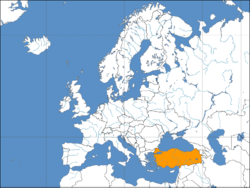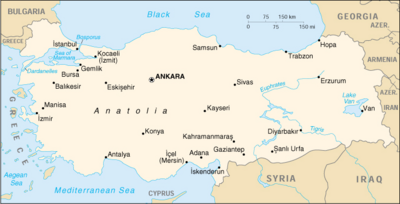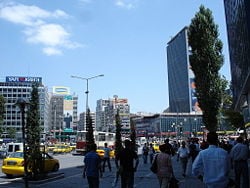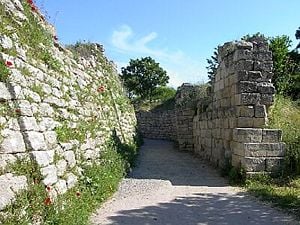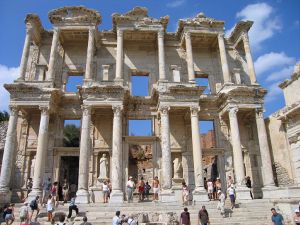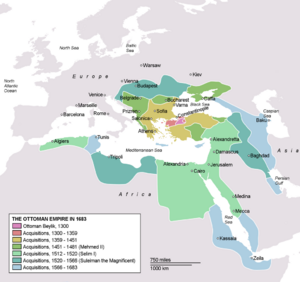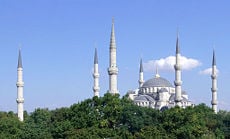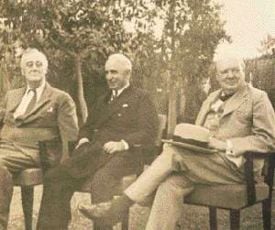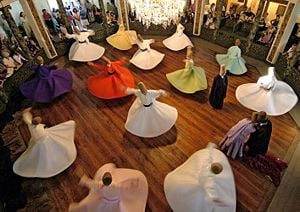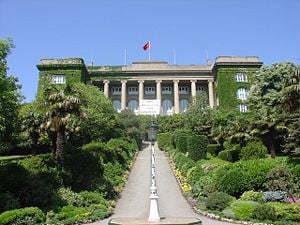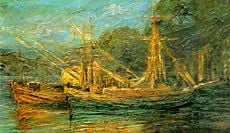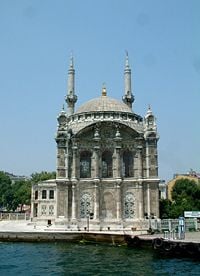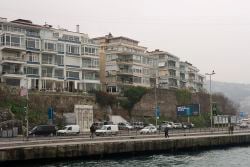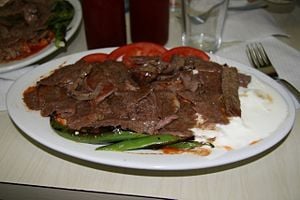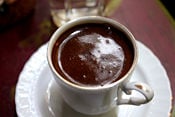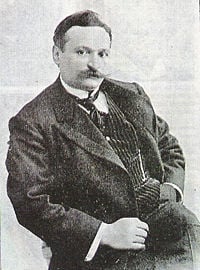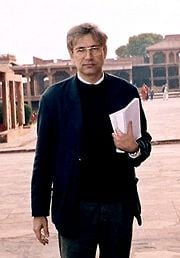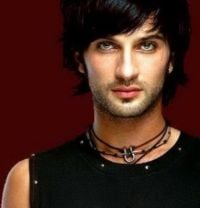Difference between revisions of "Turkey" - New World Encyclopedia
Mike Butler (talk | contribs) (Turkey - importing) |
Rosie Tanabe (talk | contribs) |
||
| (64 intermediate revisions by 11 users not shown) | |||
| Line 1: | Line 1: | ||
| − | {{ | + | {{Approved}}{{Submitted}}{{Images OK}}{{Paid}}{{Copyedited}} |
| − | {{Infobox Country | + | ''For the bird, see [[Turkey (bird)]]'' |
| − | |native_name = | + | |
| + | {{Infobox Country | ||
| + | |native_name = {{native name|tr|Türkiye Cumhuriyeti|icon=no}} | ||
|conventional_long_name = Republic of Turkey | |conventional_long_name = Republic of Turkey | ||
|common_name = Turkey | |common_name = Turkey | ||
| − | | | + | |national_anthem = <span style="line-height:1.25em;">''[[İstiklâl Marşı]]''<small><br />''Independence March''</small></span><br> |
| − | |||
|image_flag = Flag of Turkey.svg | |image_flag = Flag of Turkey.svg | ||
| − | |image_coat = | + | |image_coat = <!-- do not add an emblem, Turkey does not have any emblem! —> |
| − | |symbol_type = | + | |symbol_type = |
| + | |symbol = | ||
| + | |other_symbol_type = | ||
| + | |other_symbol = | ||
|image_map = Europe location TUR2.png | |image_map = Europe location TUR2.png | ||
| + | |map_caption = Location of '''Turkey''' | ||
|capital = [[Ankara]] | |capital = [[Ankara]] | ||
| − | |latd=39 |latm=55 | + | |latd=39 |latm=55 |latNS=N |longd=32 |longm=50 |longEW=E |
|largest_city = [[Istanbul]] | |largest_city = [[Istanbul]] | ||
| − | <!--Currently only one set of coordinates implemented: |latd=41 |latm=1 | + | <!--Currently only one set of coordinates implemented: |latd=41 |latm=1 |latNS=N |longd=28 |longm=57 |longEW=E—> |
|official_languages = [[Turkish language|Turkish]] | |official_languages = [[Turkish language|Turkish]] | ||
| − | |government_type = [[Parliamentary | + | |demonym = [[Demographics of Turkey|Turkish]] |
| − | | | + | |government_type = [[Parliamentary republic]] |
| − | | | + | |leader_title1 = [[Founding Fathers#Turkey|Founder]] |
| − | | | + | |leader_name1 = [[Mustafa Kemal Atatürk]] |
| − | | | + | |leader_title2 = [[President of Turkey|President]] |
| + | |leader_name2 = [[Abdullah Gül]] | ||
| + | |leader_title3 = [[Prime Minister of Turkey|Prime Minister]] | ||
| + | |leader_name3 = [[Recep Tayyip Erdoğan]] | ||
| + | |leader_title4 = [[List of Speakers of the Parliament of Turkey|Speaker of the Parliament]] | ||
| + | |leader_name4 = [[Cemil Çiçek]] | ||
| + | |leader_title5 = [[List of Presidents of the Constitutional Court of Turkey|President of the Constitutional Court]] | ||
| + | |leader_name5 = [[Haşim Kılıç]] | ||
| + | |legislature = [[Grand National Assembly of Turkey|Grand National Assembly]] | ||
|sovereignty_type = [[Partitioning of the Ottoman Empire|Succession]] | |sovereignty_type = [[Partitioning of the Ottoman Empire|Succession]] | ||
| − | |sovereignty_note = {{nowrap|to the [[Ottoman Empire]] | + | |sovereignty_note = {{nowrap|to the [[Ottoman Empire]]}} |
| − | |established_event1 = {{nowrap|[[ | + | |established_event1 = {{nowrap|[[Treaty of Lausanne]]}} |
| − | |established_date1 = | + | |established_date1 = July 24, 1923 |
| − | |established_event2 | + | |established_event2 = {{nowrap|Declaration of Republic}} |
| − | + | |established_date2 = October 29, 1923 | |
| − | + | |area_km2 = 783562 <!--http://unstats.un.org/unsd/demographic/products/dyb/DYB2003/Table03.pdf UN statistics, page 7 (PDF format) —> | |
| − | | | + | |area_sq_mi = 302535 <!--Do not remove per [[WP:MOSNUM]]—> |
| − | | | ||
| − | | | ||
|area_rank = 37th | |area_rank = 37th | ||
|area_magnitude = 1 E11 | |area_magnitude = 1 E11 | ||
|percent_water = 1.3 | |percent_water = 1.3 | ||
| − | | | + | |population_census = 67,803,927 <ref name=2000trcensus>{{cite web|url=http://www.citypopulation.de/Turkey-C20.html |title=2000 census |publisher=Citypopulation.de }}Retrieved October 21, 2011.</ref> |
| − | | | ||
| − | | | ||
| − | |||
|population_census_year = 2000 | |population_census_year = 2000 | ||
| − | | | + | |population_estimate = 73,722,988 <ref name=2010stat>{{cite web|url=http://www.turkstat.gov.tr/PreHaberBultenleri.do?id=8428 |title=Turkish Statistical Institute |publisher=Turkstat.gov.tr |date= |accessdate=May 16, 2011}}</ref> |
| − | | | + | |population_estimate_year = 2010 |
| − | | | + | |population_estimate_rank = 18th |
| − | | | + | |population_density_km2 = 94.1 |
| − | | | + | |population_density_sq_mi = 239.8 |
| − | | | + | |population_density_rank = 108th |
| − | | | + | |GDP_PPP_year = 2010 |
| − | | | + | |GDP_PPP = $1.116 trillion<ref name=WB-GDP-PPP>[http://siteresources.worldbank.org/DATASTATISTICS/Resources/GDP_PPP.pdf The World Bank: World Development Indicators Database. ''Gross Domestic Product 2010, PPP.''] Last revised on 1 July 2011. Retrieved October 21, 2011.</ref><ref>[http://data.worldbank.org/indicator/NY.GDP.MKTP.PP.CD The World Bank: GDP, PPP (current international $)] Retrieved October 21, 2011.</ref> |
| − | |HDI_year = | + | |GDP_PPP_rank = 15th |
| − | |HDI = 0. | + | |GDP_PPP_per_capita = $15,340<ref>[http://data.worldbank.org/indicator/NY.GDP.PCAP.PP.CD The World Bank: GDP per capita, PPP (current international $)] Retrieved October 21, 2011.</ref> |
| − | |HDI_rank = | + | |GDP_PPP_per_capita_rank = |
| − | | | + | |GDP_nominal = $735.264 billion<ref name=WB-GDP>[http://siteresources.worldbank.org/DATASTATISTICS/Resources/GDP.pdf The World Bank: World Development Indicators Database. ''Gross Domestic Product 2010.''] Last revised on 1 July 2011. Retrieved October 21, 2011.</ref> <ref>[http://data.worldbank.org/indicator/NY.GDP.MKTP.CD The World Bank: GDP (current US$)] Retrieved October 21, 2011.</ref> |
| − | | | + | |GDP_nominal_rank = 17th |
| − | |Gini_year | + | |GDP_nominal_year = 2010 |
| − | |Gini_category | + | |GDP_nominal_per_capita = $10,106<ref>[http://data.worldbank.org/indicator/NY.GDP.PCAP.CD The World Bank: GDP per capita (current US$)] Retrieved October 21, 2011.</ref> |
| − | |currency = [[Turkish | + | |GDP_nominal_per_capita_rank = |
| + | |HDI_year = 2010 | ||
| + | |HDI = {{increase}} 0.679<ref> | ||
| + | {{cite web | ||
| + | |url=http://hdr.undp.org/en/media/HDR_2010_EN_Table1.pdf | ||
| + | |title=Human Development Report 2010 | ||
| + | |format=PDF | ||
| + | |date= | ||
| + | |accessdate=2010-11-01}}</ref> | ||
| + | |HDI_rank = 85th | ||
| + | |HDI_category = <span style="color:#090;">high</span> | ||
| + | |Gini = [[List of countries by income equality|40]]<ref name = "wb-gini">{{cite web | url = http://data.worldbank.org/indicator/SI.POV.GINI/ | title = Gini Index |author= |date= |work= |publisher=World Bank |accessdate=March 2, 2011}}</ref> | ||
| + | |Gini_rank = | ||
| + | |Gini_year = 2008 | ||
| + | |Gini_category = | ||
| + | |currency = [[Turkish lira]]<ref>The [[Turkish lira]] (''Türk Lirası'', TL) replaced the [[Turkish lira#8th Emission group|Turkish new lira]] on January 1, 2009.</ref> | ||
|currency_code = TRY | |currency_code = TRY | ||
| − | |time_zone = EET | + | |time_zone = [[Eastern European Time|EET]] |
|utc_offset = +2 | |utc_offset = +2 | ||
| − | |time_zone_DST = EEST | + | |time_zone_DST = [[Eastern European Summer Time|EEST]] |
|utc_offset_DST = +3 | |utc_offset_DST = +3 | ||
| + | |date_format = dd/mm/yyyy ([[Anno Domini|AD]]) | ||
| + | |drives_on = right | ||
|cctld = [[.tr]] | |cctld = [[.tr]] | ||
| − | |calling_code | + | |calling_code = [[Telephone numbers in Turkey|90]] |
| − | + | |Website = www.turkiye.gov.tr | |
| − | |||
| − | | | ||
| − | |||
| − | |||
| − | |||
}} | }} | ||
| − | |||
| − | The region comprising modern Turkey has overseen the birth of | + | '''Turkey''', known officially as the '''Republic of Turkey''' ''(Türkiye Cumhuriyeti)'' is a [[Eurasia]]n country that stretches across the [[Anatolia]]n peninsula in [[southwest Asia]] and the [[Balkans|Balkan]] region of southeastern [[Europe]]. |
| + | |||
| + | Turkey also contains the [[Sea of Marmara]], which is used by geographers to mark the border between Europe and [[Asia]], thus making Turkey transcontinental. | ||
| + | {{toc}} | ||
| + | The region comprising modern Turkey has overseen the birth of [[civilization]]s including the [[Byzantine Empire|Byzantine]] and [[Ottoman Empire]]s. Because of its strategic location at the meeting point of two continents, Turkey's culture has a unique blend of Eastern and Western tradition, and is often described as a bridge between the two civilizations. | ||
| − | |||
==Etymology== | ==Etymology== | ||
| − | + | The name for Turkey in the [[Turkish language]], ''Türkiye,'' can be divided into two words: ''Türk,'' which means "strong" in [[Old Turkic language|Old Turkic]] and usually signifying the inhabitants of Turkey or a member of the [[Turkish people|Turkish]] or [[Turkic peoples|Turkic]] peoples, a later form of ''"tu-kin",'' name given by the [[China|Chinese]] to the people living south of the [[Altay Mountains]] of [[Central Asia]] as early as 177 B.C.E.; and the [[Arabic grammar#Nisba|abstract suffix]] ''-iye,'' which means "owner" or "related to." | |
| − | The name for Turkey in the [[Turkish language]], ''Türkiye'' | + | |
| + | The first recorded use of the term "Türk" or "Türük" as an [[exonym and endonym|autonym]] is contained in the [[Orkhon script|Orkhon inscriptions]] of the [[Göktürks]] ''(Sky Turks)'' of Central Asia (c. eighth century C.E.). The English word "Turkey" is derived from the [[Medieval Latin]] ''"Turchia"'' (c. 1369). | ||
| + | |||
| + | ==Geography== | ||
| + | [[Image:Tu-map.png|left|400px|thumb|Political map of Turkey]] | ||
| + | Turkey borders eight countries: [[Bulgaria]] to the northwest, [[Greece]] to the west, [[Georgia (country)|Georgia]] to the northeast, [[Armenia]], [[Azerbaijan]] (the [[Nakhichevan]] [[exclave]]), and [[Iran]] to the east, [[Iraq]] and [[Syria]] to the southeast. It borders the [[Mediterranean Sea]] to the south, the [[Aegean Sea]] to the west, and the [[Black Sea]] to the north. | ||
| + | |||
| + | Turkey's area, including lakes, occupies 300,948 square miles (779,452 square kilometers) of which 291,773 square miles (755,688 square kilometers) are in [[Southwest Asia]] and 9174 square miles (23,764 square kilometers) are in [[Europe]]. Turkey's size makes it the world's 37th-largest country (after [[Mozambique]]). It is somewhat bigger than [[Chile]] or the U.S. state of [[Texas]]. | ||
| + | |||
| + | The European section of Turkey, in the northwest, is [[Eastern Thrace]], and forms the borders of Turkey with Greece and Bulgaria. The Asian part of the country, [[Anatolia]] (also called Asia Minor), consists of a high central plateau with narrow coastal plains, in between the Köroğlu and East-Black Sea mountain range to the north and the [[Taurus Mountains]] to the south. | ||
| + | |||
| + | Eastern Turkey has a more mountainous landscape, and is home to the sources of rivers such as the [[Euphrates River|Euphrates]], [[Tigris River|Tigris]] and [[Aras River|Aras]], and contains [[Lake Van]] and [[Mount Ararat]], Turkey's highest point, at 16,946 feet (5165 meters). | ||
| + | |||
| + | Turkey is geographically divided into seven regions: Marmara, Aegean, Black Sea, Central Anatolia, Eastern Anatolia, Southeastern Anatolia and the Mediterranean. The uneven north Anatolian terrain running along the Black Sea resembles a long, narrow belt. This region comprises approximately one-sixth of Turkey's total land area. As a general trend, the inland Anatolian [[plateau]] becomes increasingly rugged as it progresses eastward. | ||
| + | |||
| + | [[Image:NEO ararat big.jpg|thumb|right|250px| [[Mount Ararat]] is the highest peak in Turkey and is located in the Iğdır Province in Eastern Anatolia.]] | ||
| + | |||
| + | Turkey's varied landscapes are the product of complex earth movements that have shaped the region over thousands of years and still manifest themselves in fairly frequent [[earthquake]]s and occasional [[volcano|volcanic]] eruptions. The [[Bosporus]] and the [[Dardanelles]] owe their existence to the [[fault lines]] running through Turkey that led to the creation of the [[Black Sea]]. There is an earthquake fault line across the north of the country from west to east. | ||
| + | |||
| + | Turkey has a Mediterranean temperate climate, with hot, dry summers and mild, wet and cold winters, though conditions can be much harsher in the more arid interior. Mountains close to the coast prevent Mediterranean influences from extending inland, giving the interior of Turkey a continental climate with distinct seasons. The central Anatolian Plateau is much more subject to extremes than coastal areas. Winters on the plateau are especially severe. Temperatures of minus 22°F to minus 40°F (minus 30°C to minus 40°C) can occur in the mountainous areas in the east, and snow may lie on the ground 120 days of the year. In the west, winter temperatures average below 34°F (1°C). Summers are hot and dry, with temperatures generally above 86°F (30°C) in the day. | ||
| + | |||
| + | Annual precipitation averages about 15 inches (400mm) with actual amounts determined by elevation. The driest regions are the Konya plain and the Malatya plain, where annual rainfall frequently is less than 12 inches (300mm). May is the wettest month, whereas July and August are the driest. | ||
| + | |||
| + | Natural hazards include severe earthquakes, especially in northern Turkey, along an arc extending from the Sea of Marmara to Lake Van. On August 17, 1999, a 7.4-magnitude earthquake struck north-western Turkey, killing more than 17,000 and injuring 44,000. | ||
| + | [[Image:Ankara Kizilay square.JPG|thumb|right|250px|The Kızılay Square is the heart of Ankara.]] | ||
| + | Current environmental issues concern water [[pollution]] from dumping of [[chemicals]] and [[detergents]], air pollution, particularly in urban areas, [[deforestation]], and concern for [[oil spills]] from increasing Bosphorus ship traffic. | ||
| + | |||
| + | [[Ankara]], the capital and the country's second largest city after [[Istanbul]], had a population of 4,319,167 in 2005. Centrally located in [[Anatolia]], Ankara is the center of the Turkish Government, and houses all foreign embassies. It is an important crossroads of trade, strategically located at the center of Turkey's highway and railway networks, and serves as the marketing center for the surrounding agricultural area. Istanbul is the financial, economic and cultural heart of the country. Other important cities include İzmir, Bursa, Adana, and Trabzon. In all, 12 cities have populations that exceed 500,000, and 48 cities have more than 100,000 inhabitants. | ||
| + | |||
==History== | ==History== | ||
| + | [[Image:Troy1.jpg|thumb|left|Portion of the legendary walls of Troy, identified as the site of the Trojan War (c. 1200 B.C.E.)]] | ||
| + | The Anatolian peninsula (also called Asia Minor), comprising most of modern Turkey, is one of the oldest continually inhabited regions in the world due to its location at the intersection of [[Asia]] and [[Europe]]. The earliest [[Neolithic]] settlements such as [[Çatalhöyük]] (Pottery Neolithic dating from around 7500 B.C.E.), and [[Çayönü]] (Pre-Pottery Neolithic A to Pottery Neolithic, from 7200 B.C.E. till 6600 B.C.E.), are considered to be among the earliest human settlements in the world. | ||
| − | + | The settlement of [[Troy]] starts in the Neolithic and continues into the [[Iron Age]]. Through recorded history, Anatolians have spoken Indo-European, [[Semitic language|Semitic]] and South Caucasian languages, as well as many languages of uncertain affiliation. In fact, given the antiquity of the Indo-European Hittite and Luwian languages, some scholars have proposed Anatolia as the hypothetical center from which the Indo-European languages have radiated. | |
| − | |||
| − | |||
| − | |||
| − | |||
| − | |||
| − | The | + | ===Hittites=== |
| + | [[Image:Celsus-Bibliothek2.jpg|thumb|right| The [[Celsus Library]] in [[Ephesus]], dating from 135 C.E..]] | ||
| + | The first major empire in the area was that of the [[Hittites]], from the eighteenth through the thirteenth century B.C.E. Subsequently, the [[Phrygia]]ns, an Indo-European people, achieved ascendancy until their kingdom was destroyed by the [[Cimmerians]] in the seventh century B.C.E.E. The most powerful of Phrygia's successor states were [[Lydia]], [[Caria]] and [[Lycia]]. The Lydians and Lycians spoke languages that were fundamentally Indo-European, but both languages had acquired non-Indo-European elements prior to the Hittite and [[Hellenic]] periods. | ||
| − | + | The west coast of Anatolia was meanwhile settled by the [[Ionians]], one of the [[ancient Greece|ancient Greek]] peoples. The entire area was conquered by the Persian [[Achaemenid Empire]] during the sixth and fifth centuries and later fell to [[Alexander the Great]] in 334 B.C.E. Anatolia was subsequently divided into a number of small Hellenistic kingdoms (including [[Bithynia]], [[Cappadocia]], [[Pergamum]], and [[Pontus]]), all of which had succumbed to [[Ancient Rome|Rome]] by the mid-first century B.C.E. | |
| − | |||
| − | [[ | ||
| − | + | In 324 C.E., the Roman emperor [[Constantine I]] chose [[Byzantium]] to be the new capital of the Roman Empire, renaming it [[New Rome]] (later [[Constantinople]] and [[Istanbul]]). After the fall of the [[Western Roman Empire]], it became the capital of the [[Byzantine Empire]] (Eastern Roman Empire). | |
| − | [[Image: | + | ===Ottoman Empire=== |
| + | [[Image:OttomanEmpireIn1683.png|thumb|left|300px|The Ottoman Empire at the height of its power (ca. 1680)]] | ||
| + | The House of Seljuk was a branch of the Kinik [[Oghuz Turks]] who in the ninth century resided on the periphery of the [[Muslim world]], north of the [[Caspian]] and [[Aral Sea]]s in the Yabghu [[Khagan]]ate of the Oğuz confederacy. In the tenth century, the Seljuks migrated from their ancestral homelands into the eastern Anatolian regions that had been an area of settlement for Oğuz Turkic tribes. | ||
| − | + | [[Image:Blaue moschee 6minarette.jpg|thumb|right|230px|The [[Sultan Ahmed Mosque]] (Blue Mosque) is one of the most famous architectural legacies of the Ottoman Empire.]] | |
| − | + | Following their victory over the Byzantine Empire in the [[Battle of Manzikert]] in 1071, the Turks began to abandon their nomadic roots in favor of a permanent role in Anatolia, bringing rise to the [[Seljuk Turks|Seljuk]] Empire. In 1243, the Seljuk armies were defeated by the [[Mongols]] and the power of the empire slowly disintegrated. In its wake, one of the Turkish principalities governed by [[Osman I]] was to evolve into the [[Ottoman Empire]], thus filling the void left by the collapsed Seljuks and [[Byzantines]]. | |
| − | + | The [[Ottoman Empire]] interacted with both Eastern and Western cultures throughout its 623-year history. In the sixteenth and seventeenth centuries, it was among the world's most powerful political entities, often locking horns with the powers of eastern [[Europe]] in its steady advance through the [[Balkans]] and the southern part of the [[Polish-Lithuanian Commonwealth]]. Following years of decline, the Ottoman Empire entered [[World War I]] through the [[Ottoman-German Alliance]] in 1914, and was ultimately defeated. After the war, the victorious Allied Powers sought the dismemberment of the Ottoman state through the [[Treaty of Sèvres]]. | |
| − | |||
| − | [[ | ||
| − | + | ===Republic=== | |
| − | Mustafa Kemal | + | The occupation of İstanbul and İzmir by the Allies in the aftermath of [[World War I]] prompted the establishment of the Turkish national movement. Under the leadership of Mustafa Kemal Atatürk [[Pasha]], a military commander who had distinguished himself during the [[Battle of Gallipoli]], the Turkish War of Independence was waged with the aim of revoking the terms of the [[Treaty of Sèvres]]. By September 18, 1922, the occupying armies were repelled and the country saw the birth of the new Turkish state. On November 1, the Grand National Assembly of Turkey formally abolished the Sultanate, thus ending 623 years of Ottoman rule. The [[Treaty of Lausanne]] of 1923 led to the international recognition of the sovereignty of the newly formed "Republic of Turkey" as the successor state of the [[Ottoman Empire]], and the republic was officially proclaimed on October 29, 1923, in the new capital of [[Ankara]]. |
| − | + | [[Mustafa Kemal Atatürk|Mustafa Kemal]] became the republic's first president and subsequently introduced many radical reforms with the aim of founding a new secular republic from the remnants of its Ottoman past. According to the Law on Family Names, the Turkish parliament presented Mustafa Kemal with the honorific name "Atatürk" ("Father of the Turks") in 1934. | |
| − | + | ===World War II=== | |
| + | Turkey entered [[World War II]] on the side of the Allies on February 23, 1945 as a ceremonial gesture and became a charter member of the [[United Nations]] in 1945. Difficulties faced by [[Greece]] after the war in quelling a communist rebellion, along with demands by the [[Soviet Union]] which wanted to establish military bases in the [[Turkish Straits]], prompted the [[United States]] to declare the [[Truman Doctrine]] in 1947. The doctrine enunciated American intentions to guarantee the security of Turkey and Greece, and resulted in large-scale U.S. military and economic support. | ||
| − | Following the | + | After participating with [[United Nations]] forces in the [[Korean War]], Turkey joined the [[North Atlantic Treaty Organization]] (NATO) in 1952, becoming a bulwark against Soviet expansion into the [[Mediterranean]]. Following a decade of violence on the island of [[Cyprus]] and the subsequent Athens-inspired coup, Turkey intervened militarily in 1974. Nine years later [[Turkish Republic of Northern Cyprus]] (TRNC) was established. TRNC is recognized only by Turkey. |
| + | |||
| + | ===Instability=== | ||
| + | Following the end of the single-party period in 1945, the multi-party period witnessed tensions over the following decades, and the period between the 1960s and the 1980s was particularly marked by periods of political instability that resulted in a number of military [[coup d'état|coups d'états]] in 1960, 1971, 1980, and a post-modern coup d'état in 1997. The liberalization of the Turkish economy that started in the 1980s changed the landscape of the country, with successive periods of high growth and crises punctuating the following decades. | ||
==Government and politics== | ==Government and politics== | ||
| − | |||
| − | [[ | + | Turkey is a republican parliamentary democracy. Since its foundation as a republic in 1923, Turkey has developed a strong tradition of [[secularism]]. A [[constitution]] establishes Turkey as a unitary centralized state. |
| + | |||
| + | The president, who is the chief of state and who has a largely ceremonial role, is elected by the National Assembly for a single seven-year term. The president appoints the prime minister, who is generally the head of the political party winning most seats in an election, and who has passed a parliamentary [[vote of confidence]]. The prime minister in 2007 was the former mayor of Istanbul, [[Recep Tayyip Erdoğan]], whose Islamic conservative Justice and Development Party (Turkey) won an absolute majority of parliamentary seats in the 2002 elections. The cabinet is a council of ministers appointed by the president on the nomination of the prime minister. Executive power is exercised by the prime minister and the Council of Ministers. | ||
| + | |||
| + | Legislative power is vested in the unicameral Grand National Assembly of Turkey (Turkiye Buyuk Millet Meclisi). Its 550 members are elected by popular vote by a party-list proportional representation system from 85 electoral districts to serve five-year terms. Elections were last held in November 2002. To avoid excessive political fragmentation, only parties that win at least 10 percent of the votes gain seats in parliament. Every Turkish citizen who has turned 18 years of age has the right to vote. | ||
| − | + | The judiciary is independent of the executive and the legislature. The Constitutional Court rules on the constitutionality of laws. The Council of State is the tribunal of last resort for administrative cases, and the High Court of Appeals for all others. Turkey abandoned [[Islamic law]] and adopted the [[Italy|Italian]] penal code in 1926. Compared to other Middle Eastern countries, the rate of ordinary [[crime]] is low. People are incarcerated for illegal political activity and thought crimes, such as advocating an Islamic state or cultural rights for an ethnic minority. Turkey is a member of the [[European Court of Human Rights]]. | |
| − | Turkey | ||
| − | + | The military wields political power in that it is legally responsible for protection of the Turkish Constitution and the unity of the country. It therefore plays a formal political role via the National Security Council as the guardian of the secular, unitary nature of the republic and the reforms of Atatürk. | |
| − | |||
| − | + | ===Foreign relations=== | |
| + | [[Image:Roosevelt Inonu Churchill.jpg|thumb|275px|right| [[Franklin D. Roosevelt|Roosevelt]], [[İsmet İnönü|İnönü]] and [[Winston Churchill|Churchill]] at the [[Second Cairo Conference]] in December 1943]] | ||
| − | + | Turkey's main political, economic and military relations have remained rooted within the West since the foundation of the republic and its membership to [[NATO]] in 1952. Ankara became a crucial strategic ally in diverting Soviet forces from Central Europe and preventing their expansion into the Mediterranean. Turkey also fostered relations with the Middle East, becoming the only NATO member of the [[Organization of the Islamic Conference]], as well as forging close relations with [[Israel]]. | |
| − | |||
| − | + | The [[European Union]] remains Turkey's biggest trading partner, and the presence of a well-established Turkish diaspora in Europe has contributed to extensive relations between the two over the years. Turkey became a member of the [[Council of Europe]] in 1949, applied for associate membership of the [[European Economic Community|EEC]] (predecessor of the EU) in 1959 and became an associate member in 1963. After decades of negotiations, Turkey applied for full membership of the EEC in 1987, reached a Customs Union agreement with the EU in 1995 and officially began accession negotiations on October 3, 2005. | |
| − | |||
| − | + | The long divided island of [[Cyprus]] and disputes over the air and sea boundaries of the Aegean Sea remain the main issues of disagreement between Turkey and [[Greece]]. | |
| − | [[ | + | |
| + | Since the end of the [[Cold War]], Turkey has been actively building relations with former communist countries in [[Eastern Europe]] and [[Central Asia]]. However, Turkey's relations with neighboring [[Armenia]] remained tense due to the stalemate in [[Nagorno-Karabakh]] between Armenia and [[Azerbaijan]], a Turkic-speaking neighbor and ally of Turkey, and also due to the controversy surrounding the [[Armenian Genocide]], in which actions by the Ottoman [[Young Turks]] led to the forced mass evacuation and related deaths of up to 1.5 million Armenian people. | ||
| + | |||
| + | Even though Turkey participated in the NATO-led War in [[Afghanistan]] after [[September 11, 2001, attacks]], the [[Iraq War]] faced strong domestic opposition in Turkey. A government motion which would have allowed [[U.S.]] troops to attack [[Iraq]] from Turkey couldn't reach the absolute majority of 276 votes needed in the Turkish Parliament, the final tally being 264 votes for and 250 against. This led to a cooling in relations between the U.S. and Turkey. | ||
| − | + | ===Military=== | |
| − | + | The Turkish Armed Forces consists of the army, the navy and the air force. The gendarmerie and the coast guard operate as parts of the Ministry of Internal Affairs in peace, although they are subordinated to the army and navy commands in war, during which they have both internal law enforcement and military functions. | |
| − | The | + | The president appoints the chief of the general staff, who is responsible to the prime minister. The council of ministers is responsible to the parliament for matters of national security and the adequate preparation of the armed forces to defend the country. |
| − | + | The Turkish Armed Forces is the second largest standing armed force in [[NATO]], after the U.S. Armed Forces, with a combined strength of 1,043,550 uniformed personnel serving in its five branches. Every fit heterosexual male Turkish citizen is required to serve in the military for periods ranging from three weeks to 15 months, depending on his education and job location. (Homosexuals have the right to be exempt, if they so request). | |
| − | + | In 1998, Turkey announced a program of [[modernization]] worth some US$31-billion over a ten-year period in various projects including tanks, helicopters and assault rifles. Turkey is also a level three contributor to the Joint Strike Fighter program, gaining an opportunity to develop and influence the creation of the next generation fighter spearheaded by the [[United States]]. | |
| − | + | ===Administrative divisions=== | |
| + | The territory of Turkey is subdivided into 81 provinces for administrative purposes. The provinces are organized into seven regions for census purposes only. Each province is divided into districts, for a total of 923 districts. Provinces usually bear the same name as their provincial capitals, also called the central district. Provinces with the largest populations are Istanbul (over 10 million), Ankara (over four million), Izmir (over 3.4 million), Konya (over 2.2 million), Bursa (over 2.1 million) and Adana (over 1.85 million). | ||
| − | == | + | ==Economy== |
| − | |||
| − | |||
| − | |||
| − | + | For most of its history as a republic, Turkey has adhered to a quasi-statist approach, with strict government controls over private sector participation, foreign trade, and foreign direct investment. However, during the 1980s, Turkey began a series of reforms designed to shift the economy to a more private sector, market-based model. The reforms spurred rapid growth, but this growth was punctuated by sharp recessions and financial crises in 1994, 1999 (following the [[earthquake]] of that year), and 2001, resulting in an average of 4 percent [[GDP]] growth per annum between 1981 and 2003. | |
| − | + | The GDP growth rate for 2005 was 7.4 percent, thus making Turkey one of the fastest growing economies in the world. Turkey's GDP ranks 17th in the world. It is a member of G20 industrial nations which brings together the 20 largest economies of the globe. Turkey's economy is no longer dominated by traditional [[agriculture|agricultural]] activities in the rural areas, but more so by a highly dynamic industrial complex in the major cities, mostly concentrated in the western provinces of the country, along with a developed services sector. | |
| − | The | + | The agricultural sector accounts for 11.9 percent of GDP. Turkey ranks seventh worldwide and first within the [[Muslim world]] in farm output, and has been self-sufficient in food production since the 1980s. The agricultural output has been growing at a respectable rate. However, since the 1980s agriculture has been in a state of decline in comparison to the total economy. |
| − | + | The industrial and service sectors make up 23.7 percent and 64.5 percent, respectively. Turkey ranks 21st worldwide and third within the [[Muslim]] world in factory output. Its industrial sector has 19 percent share in employment, 29 percent share in national production, and 94 percent share in total exports. The largest industry is textiles and clothing (16.3 percent of total industrial capacity in 2005 according to the State Institute of Statistics), followed by oil refining (14.5 percent). | |
| − | + | The [[tourism]] sector has experienced rapid growth in the last 20 years, and constitutes an important part of the economy. In 2005, there were 24,124,501 visitors to the country, who contributed $18.2-billion to Turkey's revenues. Other key sectors of the Turkish economy are construction, [[automobile|automotive]] industry, [[electronics]] and [[textiles]]. | |
| − | + | Chronically high inflation was brought under control and this has led to the launch of a new currency to cement the economic reforms and erase the vestiges of an unstable economy. On January 1, 2005, the Turkish Lira was replaced by the New Turkish Lira by dropping off six zeroes (1 YTL= 1,000,000 TL). As a result of continuing economic reforms, the inflation has dropped to 8.2 percent in 2005, and the unemployment rate to 10.3 percent. | |
| − | |||
| − | + | Exports totaled $85.21-billion in 2006. Export commodities included apparel, food, textiles, [[metal]] manufactures, and transport equipment. Export partners included [[Germany]] 12.9 percent, [[UK]] 8.1 percent, [[Italy]] 7.6 percent, [[U.S.]] 6.7 percent, [[France]] 5.2 percent, and [[Spain]] 4.1 percent. | |
| − | |||
| − | + | Imports totaled $120.9-billion in 2006. Import commodities included machinery, chemicals, semi-finished goods, [[fuel|fuels]], and transport equipment. Import partners included Germany 11.7 percent, [[Russia]] 11 percent, Italy 6.5 percent, [[China]] 5.9 percent, France 5 percent, U.S. 4.6 percent, and UK 4 percent. | |
| − | + | Per capita GDP was $9107 in 2006, or 69th on a list of 181 nations. The [[unemployment]] rate was 10.2 percent in 2006. Twenty percent existed below the poverty line in 2002. | |
| − | + | ==Demographics== | |
| + | As of 2005, the population of Turkey stood at 72.6 million with a growth rate of 1.5 percent yearly. An estimated 67 percent of Turkey's population lived in urban centers. The Turkish population was relatively young, with 25.5 percent falling within the 0-15 age bracket. Life expectancy in 2005 stood at 68.9 years for men and 73.8 years for women, for an overall average of 71.3 years. | ||
| − | + | After World War II, and again in the 1960s and 1970s, waves of Turkish citizens, mostly men, emigrated to [[Western Europe]] (particularly [[West Germany]]) seeking work, creating a significant diaspora. Followed by their families, the number of Turkish citizens in Europe is close to three million. Turkey has also become a destination for numerous immigrants, especially since the fall of the [[Berlin Wall]] and the consequent increase of freedom of movement in the region. These immigrants generally migrate from the former [[Soviet Bloc]] countries, as well as neighboring [[Muslim states]], either to settle and work in Turkey or to continue their journey towards the [[European Union]]. | |
| − | |||
| − | |||
| − | |||
| − | |||
| − | |||
| − | |||
| − | |||
| − | |||
| − | + | ===Ethnicity=== | |
| − | + | Turkey's ethnic diversity has built up over centuries. The Ottoman Empire welcomed millions of Spanish and Portuguese [[Jew]]s after 1492, Russian schismatics in seventeenth and eighteenth centuries, [[Nekrasov Cossacks]], Polish and Hungarian revolutionaries after 1848, [[Jews]] escaping the [[pogrom]]s and later the ''Shoah,'' White Russians fleeing the [[Bolshevik Revolution]] in 1917, Russian and other socialist or communist revolutionaries, and Trotskyites fleeing the U.S.S.R. in the 1930s. | |
| − | |||
| − | [[ | + | Since 1923, Turkey has welcomed Muslim [[refugee]]s, like [[Crimean Tatars]], [[Circassians]] and [[Chechens]] from the Russian Empire, Algerian followers of Abd-el-Kader, Mahdists from Sudan, Turkmens, Kazakhs, Kirghizs and other Central Asian Turkic-speaking peoples fleeing the U.S.S.R. and later the war-torn Afghanistan, Balkan Muslims, either Turkish-speaking or [[Bosniaks]], [[Pomaks]], [[Albanians]], and Greek [[Muslims]], fleeing either the new Christian states or later the Communist regimes, in Yugoslavia and Bulgaria for instance. |
| − | + | Article 66 of the Turkish Constitution defines a "Turk" as anyone that is "bound to the Turkish state through the bond of citizenship." Therefore, the legal use of the term "Turkish" as a [[citizen]] of Turkey is different from the ethnic definition. However, the majority of the Turkish population is of [[Turkish ethnicity]]. Other major ethnic groups include the [[Kurds]], [[Circassians]], [[Roma]], [[Arabs]] and the three officially-recognized minorities of [[Greeks]], [[Armenians]] and [[Jews]]. The largest non-Turkic ethnicity is the Kurds, a distinct ethnic group traditionally concentrated in the southeast of the country. Minorities other than the three official ones do not have any special group privileges, and while the term "minority" itself remains a sensitive issue in Turkey, it is to be noted that the degree of assimilation within various ethnic groups outside the recognized minorities is high, with the following generations adding to the [[melting pot]] of the Turkish main body. Within that main body, certain distinctions based on diverse [[Turkic]] origins could be made as well. Reliable data on the exact ethnic makeup of the population is not available, as the Turkish [[census]] statistics do not include ethnic or racial figures. | |
| − | + | ===Religion=== | |
| + | [[Image:Whirlingdervishes.JPG|thumb|300px|right|[[Mevlevi|Whirling Dervishes]] perform at the Mevlevi Museum in Konya, Central Anatolia region.]] | ||
| + | Nominally, 99 percent of the Turkish population is [[Islam|Muslim]], of whom a majority belongs to the [[Sunni Islam|Sunni]] branch of Islam. A sizeable minority of the population is affiliated with the [[Alevi]] sect. The mainstream [[Hanafi|Hanafite]] school of Sunni Islam is largely organized by the state, through the Religious Affairs Directorate, which controls all mosques and Muslim clerics. The remainder of the population belongs to other beliefs, particularly [[Christianity|Christian]] denominations ([[Greek Orthodox]], [[Armenian Apostolic]], [[Syriac Orthodox]]), [[Judaism]], [[Yezidism]] and [[Atheism]]. | ||
| − | Turkey is | + | Turkey is the location the Whirling Dervishes, known for their famous practice of slow deliberate whirling as a form of ''dhikr'' (remembrance of [[Allah]]). [[Dervish]] is a common term for an initiate of the [[Sufism|Sufi]] Path. The Mevlevi Order is a [[Sufi]] group founded by the followers of the Persian thinker [[Jalal ad-Din Muhammad]] [[Rumi]] in 1273 in Konya. |
| − | + | There is a strong tradition of secularism in Turkey. Even though the state has no official religion nor promotes any, it actively monitors the area between the religions. The constitution recognizes [[freedom of religion]] for individuals, whereas religious communities are placed under the protection of the state; but the constitution explicitly states that they cannot become involved in the political process (by forming a religious party, for instance) or establish faith-based schools. No party can claim that it represents a form of religious belief; nevertheless, religious sensibilities are generally represented through conservative parties. Turkey prohibits by law the wearing of [[Hijab|religious headcover]] and theo-political symbolic garments for both genders in government buildings, schools, and universities. The law was upheld by the Grand Chamber of the European Court of Human Rights as "legitimate" in ''[[Leyla Şahin v. Turkey]]'' on November 10, 2005. | |
| − | + | === Language === | |
| − | + | [[Turkish language|Turkish]] is the sole official language throughout Turkey. Reliable figures for the linguistic makeup of the populace are not available. The Turkish language is a member of the [[Oghuz Turks|Oghuz]] subdivision of [[Turkic languages]], which in turn is a branch of the proposed Altaic language family. Turkish is for the most part, mutually intelligible with other Oghuz languages like [[Azeri]], [[Crimean Tatar]], [[Gagauz]], [[Turkmen]] and [[Urum]], and to a lesser extent with other Turkic languages. | |
| − | |||
| − | |||
| − | |||
| − | [[ | + | Modern Turkish differs greatly from the Ottoman Turkish language, the administrative and literary language of the Ottoman Empire, which was influenced heavily by Arabic and Persian. During the Ottoman period, the language was essentially a mixture of Turkish, Persian, and Arabic, differing considerably from the everyday language spoken by the empire's Turkish subjects, to the point that they had to hire ''arzıhâlcis'' (request-writers) to communicate with the state. After the proclamation of the [[Turkish Republic]], many of the foreign borrowings in the language were replaced with Turkic equivalents in a language reform. Almost all government documents and [[literature]] from the Ottoman period and the early years of the Republic are thus unintelligible to today's Turkish-speaker, without translation. |
| − | + | Historically, there were many [[dialect|dialects]] of Turkish that were spoken throughout [[Anatolia]] and the [[Balkans]] that differed significantly from each other. After the proclamation of the Republic, the [[Istanbul]] dialect was adopted as the standard. There is no official effort to protect regional dialects, and some are under threat of disappearing as they face the standard language used in the media and educational system. | |
| − | + | Nevertheless, the public broadcaster [[Turkish Radio and Television Corporation|TRT]] broadcasts programs in local languages and dialects of [[Arabic language|Arabic]], [[Bosnian language|Bosnian]], [[Circassian language|Circassian]] and [[Kurdish language|Kurdish]] a few hours per week. | |
| − | |||
| − | + | ===Men and women=== | |
| + | Turkish law guarantees equal pay for equal work and has opened most educational programs and occupations to women. Men tend to dominate the high-status occupations in business, the military, government, the professions, and academia. Traditionally, women do domestic work and should not work in public or with unrelated men. In small towns, men dominate public areas while women dominate the private space at home. In the [[mosque]], females pray in a separate area. Movie theaters, restaurants, beaches, and public parks often have a section for men and a "family" section for families and single women. It is not considered proper for a man to take a seat next to an unrelated woman on public transport. Many of these restrictions have eased in cities, but coffeehouses and some bars remain exclusively for men. | ||
| − | + | ===Marriage and the family=== | |
| − | In | + | In traditional Turkish society, kin groups controlled the selection of spouses. In 1926, the revolutionary Turkish government abolished Islamic [[family]] law and adopted a modified version of the family law in the [[Swiss civil code]], which recognizes civil [[marriage]] ceremonies only, and prescribes monogamy. Most marriages occur with the couple's consent, but families still play a role recommending and screening potential spouses, especially for their daughters. [[Divorce]] occurs infrequently. The law recognizes six grounds for divorce: adultery, death threats or serious assaults, crime or a dishonorable life, desertion, mental infirmity, and incompatibility. Establishing one of these grounds has proved difficult, and a couple cannot divorce by mutual consent. |
| − | + | Although most households comprise one nuclear family, the ideal household, especially among the rural and urban wealthy, is an extended family, in which a son and his bride live in his parents' home after marriage. The next kinship unit is the “sulale,” consisting of relatives connected by a common male ancestor. While kin groups are important to old, noble Ottoman families and tribal peoples, it is of little significance to most Turks. | |
| − | + | The father or oldest male is the head of the family, who demands respect and obedience. The mother is respected, although her relationship with her children tends to be warm and informal. Women are responsible for the home, and men are responsible for providing the income and representing the household to the outside world. Before the 1960s, even grocery shopping was a male duty. The new Family Law grants women equal rights to [[private property]] and [[inheritance]]. | |
| − | + | Boys are taught to be courageous, assertive, proud, and respectful of elders. When they are circumcised between ages nine and 12, they are told to be as brave as lions. Girls are taught to be modest, compliant, to support males, to be virtuous, and skilled in domestic tasks. | |
| − | |||
| − | |||
| − | |||
| − | [[ | + | ===Education=== |
| + | [[Image:AFL-garden.jpg|thumbnail|300px|right|[[Ankara Science High School]] in [[Ankara]]]] | ||
| + | Education is compulsory and free from ages six to 15. Children may attend kindergarten from age six. The [[elementary school]] provides eight years of education for children between the ages of seven and 15. In primary school, basic information, [[Turkish language]], [[mathematics]], [[sciences]], [[social sciences]], [[art]], [[music]], [[physical education]], [[handicraft]], [[English language]], and sometimes another foreign language (generally [[French Language|French]] or [[German Language|German]]) are taught. There are two types of elementary schools, public (governmental) and private. | ||
| − | + | At the end of eighth grade, students take a 100-question exam, [[OKS]], which lasts for two hours. It tests skills in [[Turkish language|Turkish]], [[mathematics]], natural and social sciences learned through the elementary school. According to their scores, they are placed to different kinds of high schools. | |
| − | |||
| − | [[ | + | The [[high school]] lasts for four years, with some high schools having an additional one year of English preparatory classes. The different kinds of high schools of the Turkish education system include: Public high schools, Anatolian high schools which boost language skills by instructing part of science courses in a foreign language (English, German or French), science high schools focusing on [[science]] education; [[vocational]] high schools, which focus on a vocation like [[tourism]], industry, and electrical work, Imam-Hatip high schools, which educate imams, and private high schools established by private enterprises. Almost all private high schools give education in English (some lessons are in English) and teach a second foreign language. |
| − | + | [[Image:RobertCollegeGouldHall1.jpg|thumb|300px|[[Robert College]] of Istanbul]] | |
| − | + | When students complete the tenth grade, they choose tracks leading to certain specializations. There four tracks are: Turkish-math, science, social sciences and languages. In vocational high schools no tracks are offered, while in science high schools only the science track is offered. Tracks lead to presumed professions. | |
| − | + | * Turkish-math track professions are: International relations, law, education, psychology, economy, business management, among others. | |
| + | * Science track: Engineering, computer science, medicine, and other science related professions. | ||
| + | * Social science track: History, geography, and education. | ||
| + | * Language track: All language-linguistics professions. | ||
| − | + | At the end of twelfth grade, students take a high school finishing examination and they are required to pass this in order to take the [[ÖSS]] and continue their studies at a university. | |
| − | |||
| − | + | Universities provide either two or four years of education for undergraduate studies whereas for graduate studies, a further two years is necessary. There are around 820 higher education institutions including universities with a total student enrollment of over one million. | |
| − | |||
| − | + | The literacy rate is 95.3 percent for men and 79.6 percent for women, for an overall average of 87.4 percent. The low figure for women is attributed to prevailing feudal attitudes against women in the Arab- and Kurdish-inhabited south-eastern provinces. | |
| − | |||
| − | + | ===Class=== | |
| − | + | Wealth and education determine social status. Turkey has the wealthy urban educated class, the urban middle class, the urban lower class, the large rural landowner class, and the general rural population. A university education is the minimum qualification for entry into the urban educated class, in which there are numerous substrata. Most members of the urban upper class speak at least one Western language, are familiar with European or American life and culture, and are connected to the diplomatic and foreign business communities. The urban lower class includes semiskilled and unskilled laborers, low-paid service workers, and the urban unemployed. The high rate of migration of young villagers to urban areas makes this the most rapidly growing class. About 30 percent of the population is rural farmers, often referred to as peasants. | |
| − | Turkey has a | + | ==Culture== |
| + | [[Image:Turkishpaintings14.jpg|thumb|230px| A painting by [[Nazmi Ziya Guran]] (1881–1937)]] | ||
| + | Turkey has a diverse culture that is a blend of various elements of the [[Oğuz Turkic]] and [[Anatolian]], culture of the [[Ottoman Empire]] (which was itself a continuation of both [[Greco-Roman]] and [[Islamic]] cultures), and [[Western]] culture and traditions which started with the Westernization of the Ottoman Empire. This mix is a result of the encounter of Turks with the peoples who were in their path during their migration from Central Asia to the West. As Turkey transformed from the religion-based former Ottoman Empire into a modern nation-state with a strong separation of state and religion, an outpouring of artistic expression followed. In the early years of the republic, the government invested in museums, theaters, and architecture. Turkish culture, therefore, is a product of efforts to be "modern" and Western, combined with traditional religious and historical values. | ||
| − | [[ | + | ===Architecture=== |
| + | [[Image:Meczet Ortaköy Istambuł RB1.jpg|thumb|200px|left|Ortaköy mosque, Istanbul]] | ||
| + | [[File:Arnavutköy, Bebek Arnavutköy Cd No-115, 34345 Beşiktaş-İstanbul, Turkey - panoramio (3).jpg|250px|right| [[Yalı|Waterfront houses]] in [[Arnavutköy]], [[Istanbul]]]] | ||
| + | Ottoman architecture, with its [[Byzantine Empire|Byzantine]] and Islamic elements, mastered the technique of building vast inner spaces confined by seemingly weightless yet massive domes, and achieving perfect harmony. Leaders of the new republic, who wanted to catch up with the material culture and technology of the West, turned to contemporary western European styles. Ankara was transformed from an insignificant town of 20,000 people, to a modern capital with monumental government buildings symbolizing the ambitions of the new state. The Western buildings had indoor plumbing and electricity. Turkey's first skyscraper, a commercial office building, was built in 1959 in Ankara. Since the 1950s, growing squatter settlements surrounded modern city centers, to the extent that by 2007, between 50 and 60 percent of Turkey's urban population lived in such housing. Most Turkish homes are divided into a (a public reception room) and a "harem" (private family quarters). Traditionally, male guests stay in the public reception room, while women stay in the harem. Traditional homes have an enclosed courtyard where women can perform domestic tasks. | ||
| − | [[Image: | + | ===Cuisine=== |
| + | [[Image:Iskender kebap.jpg|right|thumb|300px|left|Iskender kebab served in [[Bursa]]]] | ||
| + | [[Image:TurkishDelightDisplay.jpg|thumb|300px|right|A display of Turkish delight in [[Istanbul]]]] | ||
| + | [[Turkish cuisine]] blends ingredients and recipes inherited from the territories covered by the [[Ottoman Empire]] with the Turkic and Central Asian cuisine. Turkish cuisine is not homogeneous. Aside from common Turkish specialties which can be found throughout the country, there are also region-specific specialties. The [[Black Sea]] region's cuisine is based on [[corn]] and [[anchovies]]. The southeast is famous for its ''kebabs,'' ''mezes'' and dough-based desserts such as ''baklava,'' ''kadayıf'' and ''künefe.'' Especially in the western parts of Turkey, where [[olive]] trees are grown abundantly, olive oil is used for cooking. The cuisines of the [[Aegean]], Marmara and [[Mediterranean]] regions display basic characteristics of Mediterranean cuisine as they are rich in vegetables, [[herbs]] and [[fish]]. Central Anatolia is famous for its pastry specialties such as ''keşkek,'' ''mantı,'' and ''gözleme.'' | ||
| + | |||
| + | Cities have numerous restaurants and snack stands. Some specialize in kebabs, soups, meat wraps made with ''pide'' (a flat bread), pastries, and fish. Others offer stews, pilafs, vegetables, and deserts. Some restaurants cater for workers, who eat only breakfast and the evening meal at home. Higher-class restaurants set aside a section for women and families. American fast-food chains have become popular. [[Pork]] is forbidden to [[Muslims]]. | ||
| − | + | Many Turks drink [[beer]], [[wine]], and liquors. There are a few local brands of lager such as Tekel Birasi and Marmara34 and a large variety of international beers. There are a variety of local wines such as Kavaklıdere, Doluca, Kayra, Pamukkale and Diren. [[Rakı]], a traditional alcoholic beverage flavored with [[anise]], is the usual drink with ''meze,'' [[fish]] or kebabs. [[Tea]] is commonly drunk throughout the entire day, thick [[coffee]] usually taken after a meal, ''ayran'' (buttermilk), and ''boza'' (a [[fermentation|fermented]] bulgur drink taken in the winter). [[Carbonation|Carbonated]] soft drinks have become popular with young people. | |
| − | + | ===Etiquette=== | |
| + | [[Image:Turkishcoffee.jpg|right|thumb|175px|Traditional [[Turkish coffee]] is ubiquitous in Turkish homes]] | ||
| + | Older men should be addressed with the title "bey" (mister), and women with the title "hanim" (lady). Adults of the opposite sex may not act casually or show affection toward each other in public. Friends of the same sex may hold hands and greet each other with kisses on the cheek. Men shake hands upon meeting, but a man does not shake a woman's hand unless she extends it to him. Business meetings are preceded by [[tea]] and unrelated conversation. Consideration for companions is important. One does not drink, smoke, or eat something without first offering to share it with one's companions. | ||
| − | == | + | ===Literature=== |
| − | + | [[Image:Tevfik Fikret2.jpg|thumb|left|200px|Tevfik Fikret (1867–1915), a prominent poet of the late Ottoman era.]] | |
| − | + | [[Image:Orhan Pamuk3.jpg|thumb|left|180px|right|Orhan Pamuk, winner of the 2006 Nobel Prize for literature.]] | |
| + | The [[history]] of [[Turkish literature]] is traced back to the Orkhon inscriptions. Most Turkish literature was verbal before the arrival of Islam, which brought Persian structures, such as ''mesnevi'' and ''gazel''. In the nineteenth century, artists began to use western structures. | ||
| − | + | Poetry dominates modern Turkish literature. The poetic tradition may be traced back to the thirteenth century, when folk poetry began to emerge. There are two poetic traditions: the ''aşık/ozan'' style, which was mostly secular; and the explicitly religious style, which emerged from the gathering places of the Sufi religious orders and Shi'a groups. | |
| − | |||
| − | + | Much ''aşık/ozan'' poetry, being almost exclusively oral until the nineteenth century, remains anonymous, and few poems have survived, the eleventh century Turkic epic ''Köroğlu'' being one of them. ''Aşıks'' were minstrels who traveled through Anatolia performing their songs on the ''bağlama'', a mandolin-like instrument. The aşık/ozan tradition was revived in the twentieth century by Aşık Veysel Şatıroğlu (1894–1973), Aşık Mahzuni Şerif (1938–2002), Neşet Ertaş (1943– ), among others. | |
| − | |||
| − | |||
| − | |||
| − | |||
| − | |||
| − | |||
| − | |||
| − | |||
| − | |||
| − | |||
| − | |||
| − | |||
| − | |||
| − | + | Ottoman ''divan'' (collected works) poetry was a highly ritualized and symbolic art form, having inherited from Persian poetry a wealth of symbols whose meanings and interrelationships were prescribed. In the early years of the Republic of Turkey, authors including Ahmed Hakim and Ya Kendal Beatle (1884–1958) continued the Ottoman tradition of formal verse. | |
| − | |||
| − | |||
| − | |||
| − | |||
| − | |||
| − | |||
| − | |||
| − | |||
| − | |||
| − | |||
| − | |||
| − | |||
| − | |||
| − | |||
| − | |||
| − | |||
| − | |||
| − | |||
| − | |||
| − | + | Less formal “Grip” poets Orhan Veli Kanık (1914–1950), Melih Cevdet Anday (1915–2002), and Oktay Rifat (1914–1988) sought to create a popular art, and were inspired by contemporary French poets like Jacques Prévert. A further group of poets, including Turgut Uyar (1927–1985), Edip Cansever (1928–1986), Cemal Süreya (1931–1990), Ece Ayhan (1931–2002), and İlhan Berk (1918– ), reacted against the Garip movement and sought to create a more abstract poetry through the use of jarring and unexpected language, complex images, and the association of ideas. | |
| − | |||
| − | |||
| − | |||
| − | |||
| − | |||
| − | |||
| − | |||
| − | |||
| − | |||
| − | |||
| − | |||
| − | |||
| − | |||
| − | |||
| − | |||
| − | |||
| − | |||
| − | |||
| − | |||
| − | |||
| − | |||
| − | |||
| − | |||
| − | |||
| − | |||
| − | |||
| − | |||
| − | |||
| − | |||
| − | |||
| − | |||
| − | |||
| − | |||
| − | |||
| − | |||
| − | |||
| − | |||
| − | |||
| − | |||
| − | |||
| − | |||
| − | |||
| − | |||
| − | |||
| − | |||
| − | |||
| − | |||
| − | |||
| − | |||
| − | |||
| − | |||
| − | |||
| − | |||
| − | |||
| − | |||
| − | + | Other significant poets include Fazıl Hüsnü Dağlarca (1914– ), who wrote poems dealing with [[life]], death, [[God]], [[time]], and the cosmos; Behçet Necatigil (1916–1979), whose somewhat allegorical poems explore middle-class daily life; Can Yücel (1926–1999), a poet and translator; and leftist poet İsmet Özel (1944– ), whose poetry since the 1970s has shown a strong mystical and even Islamist influence. | |
| − | |||
| − | |||
| − | |||
| − | |||
| − | |||
| − | |||
| − | |||
| − | |||
| − | |||
| − | |||
| − | |||
| − | |||
| − | |||
| − | |||
| − | |||
| − | |||
| − | |||
| − | |||
| − | |||
| − | |||
| − | |||
| − | + | The backgrounds of twentieth century novelists can be traced back to "Young Pens" (Genç Kalemler) journal in Ottoman period, which had a nationalistic perspective of social and political issues. With the declaration of the republic, Turkish literature became interested in folkloric styles, and mixed western and traditional forms. | |
| − | |||
| − | |||
| − | |||
| − | |||
| − | |||
| − | |||
| − | |||
| − | |||
| − | |||
| − | |||
| − | |||
| − | |||
| − | |||
| − | |||
| − | |||
| − | |||
| − | |||
| − | |||
| − | |||
| − | |||
| − | |||
| − | |||
| − | |||
| − | |||
| − | |||
| − | |||
| − | |||
| − | |||
| − | |||
| − | |||
| − | |||
| − | |||
| − | |||
| − | |||
| − | |||
| − | |||
| − | |||
| − | |||
| − | |||
| − | |||
| − | |||
| − | |||
| − | |||
| − | |||
| − | |||
| − | |||
| − | |||
| − | |||
| − | |||
| − | |||
| − | + | [[Orhan Pamuk]], a leading Turkish novelist of post-modern literature, was hugely popular in Turkey, and his work had been translated into more than 20 languages. Pamuk won the [[Nobel Prize|Nobel Prize for Literature]] in 2006, with his melancholic point of view of various cultures in [[Istanbul]]. | |
| − | + | ===Movies=== | |
| − | + | The first [[film]] showing in [[Turkey]] was held in the Yıldız Palace, Istanbul, in 1896. | |
| − | + | The first Turkish movie, a documentary produced by Fuat Uzkinay in 1914, depicted the destruction of the [[Russia]]n monument in [[Ayastefanos]]. Before 1950, Turkish cinema was greatly influenced by the theater as well as by [[World War II]]. After 1950, Turkish cinema was able to develop as a separate art, with a more professional caliber of talents. Between 1950 and 1966, Turkey had more than 50 movie directors. The film "''Susuz Yaz''" ''(Dry Summer)'', made by [[Metin Erksan]], won the [[Golden Bear|Golden Bear Award]] at the [[Berlin Film Festival]] in 1964. | |
| − | |||
| − | |||
| − | |||
| − | |||
| − | |||
| − | |||
| − | |||
| − | + | In 1970, approximately 220 films were made and this figure reached 300 in 1972. Turkish cinema gave birth to its legendary stars, including Kemal Sunal, Kadir İnanır, Türkan Şoray and Şener Şen. After this period however, the [[cinema]] began to lose its audiences, due to nationwide TV broadcasts. After 1970, a new and young generation of directors emerged, but they had to cope with an increased demand for video films after 1980. | |
| − | |||
| − | |||
| − | |||
| − | |||
| − | |||
| − | |||
| − | |||
| − | |||
| − | |||
| − | |||
| − | |||
| − | |||
| − | |||
| − | |||
| − | |||
| − | |||
| − | |||
| − | |||
| − | |||
| − | |||
| − | |||
| − | |||
| − | |||
| − | |||
| − | |||
| − | |||
| − | |||
| − | |||
| − | |||
| − | |||
| − | |||
| − | |||
| − | |||
| − | |||
| − | |||
| − | |||
| − | |||
| − | |||
| − | |||
| − | + | ===Music=== | |
| − | + | [[Image:Tarkan.jpg|thumb|right|200px|[[Tarkan]], a popular Turkish singer]] | |
| − | + | The music of Turkey includes elements of Central Asian folk music, Arabic, Persian classical music, ancient Greco-Roman music and modern European and American popular music. The biggest Turkish pop star of the twentieth century was probably Sezen Aksu, known for her light pop music, and for overseeing the Turkish contribution to the [[Eurovision Song Contest]] | |
| − | |||
| − | |||
| − | |||
| − | |||
| − | |||
| − | |||
| − | |||
| − | |||
| − | |||
| − | |||
| − | |||
| − | |||
| − | |||
| − | |||
| − | |||
| − | |||
| − | |||
| − | |||
| − | |||
| − | |||
| − | |||
| − | |||
| − | |||
| − | |||
| − | |||
| − | |||
| − | |||
| − | |||
| − | |||
| − | |||
| − | |||
| − | |||
| − | |||
| − | |||
| − | |||
| − | |||
| − | |||
| − | |||
| − | + | European classical composers in the eighteenth century were fascinated by Turkish music, particularly the key role given to the brass and percussion instruments in Ottoman [[Janissary]] bands, the first marching military bands. [[Joseph Haydn]] wrote his ''Military Symphony'' to include Turkish instruments, as did [[Ludwig van Beethoven]] in his ''Symphony Number 9,'' and [[Wolfgang Amadeus Mozart|Mozart]] wrote the "Ronda alla turca" in his ''Sonata in A major.'' Although this Turkish influence was a fad, it introduced the [[cymbals]], [[bass drum]], and [[bells]] into the [[symphony orchestra]], where they remain. | |
| − | |||
| − | |||
| − | |||
| − | |||
| − | |||
| − | |||
| − | |||
| − | |||
| − | |||
| − | |||
| − | |||
| − | |||
| − | |||
| − | |||
| − | |||
| − | |||
| − | |||
| − | |||
| − | |||
| − | |||
| − | + | ===Sport=== | |
| − | + | The most popular sport in Turkey by far is [[soccer|football (soccer)]], with certain professional and national matches drawing tens of millions of viewers on television. Nevertheless, other sports such as basketball and motor sports (following the inclusion of Istanbul Park on the Formula 1 racing calendar) have also become popular. The traditional Turkish national sport has been the ''Yağlı güreş'' (oiled wrestling) since Ottoman times. | |
| − | == | + | ==Notes== |
| − | + | <references/> | |
| − | |||
| − | |||
| − | |||
| − | |||
| − | |||
| − | |||
| − | |||
| − | |||
| − | |||
| − | * | + | ==References== |
| − | + | * Bal, İdris. 2004. ''Turkish foreign policy in post cold war era.'' Boca Raton, FL: BrownWalker Press. ISBN 1581124236 | |
| − | + | * Çarkoğlu, Ali, and Barry M. Rubin. 2006. ''Religion and politics in Turkey.'' London: Routledge. ISBN 0415348315 | |
| − | + | * Extra, Guus, and D. Gorter. 2001. ''The other languages of Europe: demographic, sociolinguistic, and educational perspectives.'' Clevedon, UK: Multilingual Matters. ISBN 1853595098 | |
| − | + | * Finly, Carter Vaughn. 2004. ''The Turks in World History.'' Oxford University Press, USA. ISBN 0195177266 | |
| − | + | * Goodwin, Godfrey. 1971. ''A history of Ottoman architecture.'' Baltimore: Johns Hopkins Press. ISBN 080181202X | |
| − | + | * Hale, William M. 1994. ''Turkish politics and the military.'' London: Routledge. ISBN 0415024552 | |
| − | + | * Huston, James A. 1988. ''Outposts and allies: U.S. Army logistics in the Cold War, 1945-1953.'' Selinsgrove: Susquehanna University Press. ISBN 0941664848 | |
| − | + | * Kinross, Patrick Balfour. 1977. ''The Ottoman centuries: the rise and fall of the Turkish empire.'' New York: Morrow. ISBN 0688030939 | |
| − | + | * Manco, Ural. "TURKS IN EUROPE: FROM A GARBLED IMAGE TO THE COMPLEXITY OF MIGRANT SOCIAL REALITY." | |
| − | + | * Mango, Andrew. 2000. ''Atatürk.'' Woodstock, NY: Overlook Press. ISBN 1585670111 | |
| + | * Mango, Andrew. 2004. ''The Turks Today.'' Overlook. ISBN 1585676152 | ||
| + | * Mango, Cyril A. 2002. ''The Oxford history of Byzantium.'' Oxford: Oxford University Press. ISBN 0198140983 | ||
| + | * Nas, Tevfik F., and Mehmet Odekon. 1992. ''Economics and politics of Turkish liberalization.'' Bethlehem: Lehigh University Press. ISBN 0585231249 | ||
| + | * Pope, Hugh and Nicole, 2004. ''Turkey Unveiled.'' Overlook. ISBN 1585675814 | ||
| + | * Rubin, Heper, Metin. 2002. ''Political Parties in Turkey.'' Routledge (UK). ISBN 0714652741 | ||
| + | * Shankland, David. 2003. ''The Alevis in Turkey the emergence of a secular Islamic tradition.'' London: RoutledgeCurzon. ISBN 020341750X | ||
| + | * Shaw, Stanford J., and Ezel Kural Shaw. 1976. ''History of the Ottoman Empire and modern Turkey.'' Cambridge: Cambridge University Press. ISBN 0521212804 | ||
| + | * Wink, André. 1991. Al-Hind, ''The making of the Indo-Islamic world.'' Leiden: E.J. Brill. ISBN 9004095098 | ||
==External links== | ==External links== | ||
| − | + | All links retrieved May 2, 2023. | |
| − | |||
| − | |||
| − | * [http://www. | + | * [http://www.everyculture.com/To-Z/Turkey.html Turkey] ''Countries and Their Cultures'' |
| − | + | * [http://news.bbc.co.uk/1/hi/world/europe/country_profiles/1022222.stm Turkey] ''BBC Country Profiles'' | |
| − | + | ||
| − | * [http:// | ||
| − | |||
| − | |||
| − | |||
| − | |||
| − | |||
| − | |||
| − | |||
| − | |||
| − | |||
| − | |||
| − | |||
| − | |||
| − | |||
| − | |||
| − | |||
| − | + | {{credit|Turkey|133354459|Geography_of_Turkey|136832625|Name_of_Turkey|134027677|Demography_of_Turkey|141229274|Turkish_people|142348205|Religion_in_Turkey|136027964|Education_in_Turkey|135820831|Turkish_cuisine|137115596|Cinema_of_Turkey|135920864|Ankara|136575001}} | |
| − | |||
| − | |||
| − | |||
| − | |||
| − | + | [[Category:Geography]] | |
| + | [[Category:Countries]] | ||
| + | [[Category:Middle East]] | ||
Latest revision as of 00:22, 3 May 2023
For the bird, see Turkey (bird)
| Türkiye Cumhuriyetino Republic of Turkey |
||||
|---|---|---|---|---|
|
||||
| Anthem: İstiklâl Marşı Independence March |
||||
| Location of Turkey
|
||||
| Capital | Ankara | |||
| Largest city | Istanbul | |||
| Official languages | Turkish | |||
| Demonym | Turkish | |||
| Government | Parliamentary republic | |||
| - | Founder | Mustafa Kemal Atatürk | ||
| - | President | Abdullah Gül | ||
| - | Prime Minister | Recep Tayyip Erdoğan | ||
| - | Speaker of the Parliament | Cemil Çiçek | ||
| - | President of the Constitutional Court | Haşim Kılıç | ||
| Legislature | Grand National Assembly | |||
| Succession | to the Ottoman Empire | |||
| - | Treaty of Lausanne | July 24, 1923 | ||
| - | Declaration of Republic | October 29, 1923 | ||
| Area | ||||
| - | Total | 783,562 km² (37th) 302,535 sq mi |
||
| - | Water (%) | 1.3 | ||
| Population | ||||
| - | 2010 estimate | 73,722,988 [1] (18th) | ||
| - | 2000 census | 67,803,927 [2] | ||
| - | Density | 94.1/km² (108th) 239.8/sq mi |
||
| GDP (PPP) | 2010 estimate | |||
| - | Total | $1.116 trillion[3][4] (15th) | ||
| - | Per capita | $15,340[5] | ||
| GDP (nominal) | 2010 estimate | |||
| - | Total | $735.264 billion[6] [7] (17th) | ||
| - | Per capita | $10,106[8] | ||
| Gini (2008) | 40[9] | |||
| Currency | Turkish lira[10] (TRY) |
|||
| Time zone | EET (UTC+2) | |||
| - | Summer (DST) | EEST (UTC+3) | ||
| Internet TLD | .tr | |||
| Calling code | [[+90]] | |||
Turkey, known officially as the Republic of Turkey (Türkiye Cumhuriyeti) is a Eurasian country that stretches across the Anatolian peninsula in southwest Asia and the Balkan region of southeastern Europe.
Turkey also contains the Sea of Marmara, which is used by geographers to mark the border between Europe and Asia, thus making Turkey transcontinental.
The region comprising modern Turkey has overseen the birth of civilizations including the Byzantine and Ottoman Empires. Because of its strategic location at the meeting point of two continents, Turkey's culture has a unique blend of Eastern and Western tradition, and is often described as a bridge between the two civilizations.
Etymology
The name for Turkey in the Turkish language, Türkiye, can be divided into two words: Türk, which means "strong" in Old Turkic and usually signifying the inhabitants of Turkey or a member of the Turkish or Turkic peoples, a later form of "tu-kin", name given by the Chinese to the people living south of the Altay Mountains of Central Asia as early as 177 B.C.E.; and the abstract suffix -iye, which means "owner" or "related to."
The first recorded use of the term "Türk" or "Türük" as an autonym is contained in the Orkhon inscriptions of the Göktürks (Sky Turks) of Central Asia (c. eighth century C.E.). The English word "Turkey" is derived from the Medieval Latin "Turchia" (c. 1369).
Geography
Turkey borders eight countries: Bulgaria to the northwest, Greece to the west, Georgia to the northeast, Armenia, Azerbaijan (the Nakhichevan exclave), and Iran to the east, Iraq and Syria to the southeast. It borders the Mediterranean Sea to the south, the Aegean Sea to the west, and the Black Sea to the north.
Turkey's area, including lakes, occupies 300,948 square miles (779,452 square kilometers) of which 291,773 square miles (755,688 square kilometers) are in Southwest Asia and 9174 square miles (23,764 square kilometers) are in Europe. Turkey's size makes it the world's 37th-largest country (after Mozambique). It is somewhat bigger than Chile or the U.S. state of Texas.
The European section of Turkey, in the northwest, is Eastern Thrace, and forms the borders of Turkey with Greece and Bulgaria. The Asian part of the country, Anatolia (also called Asia Minor), consists of a high central plateau with narrow coastal plains, in between the Köroğlu and East-Black Sea mountain range to the north and the Taurus Mountains to the south.
Eastern Turkey has a more mountainous landscape, and is home to the sources of rivers such as the Euphrates, Tigris and Aras, and contains Lake Van and Mount Ararat, Turkey's highest point, at 16,946 feet (5165 meters).
Turkey is geographically divided into seven regions: Marmara, Aegean, Black Sea, Central Anatolia, Eastern Anatolia, Southeastern Anatolia and the Mediterranean. The uneven north Anatolian terrain running along the Black Sea resembles a long, narrow belt. This region comprises approximately one-sixth of Turkey's total land area. As a general trend, the inland Anatolian plateau becomes increasingly rugged as it progresses eastward.
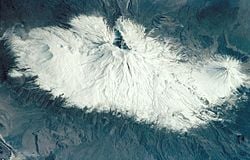
Turkey's varied landscapes are the product of complex earth movements that have shaped the region over thousands of years and still manifest themselves in fairly frequent earthquakes and occasional volcanic eruptions. The Bosporus and the Dardanelles owe their existence to the fault lines running through Turkey that led to the creation of the Black Sea. There is an earthquake fault line across the north of the country from west to east.
Turkey has a Mediterranean temperate climate, with hot, dry summers and mild, wet and cold winters, though conditions can be much harsher in the more arid interior. Mountains close to the coast prevent Mediterranean influences from extending inland, giving the interior of Turkey a continental climate with distinct seasons. The central Anatolian Plateau is much more subject to extremes than coastal areas. Winters on the plateau are especially severe. Temperatures of minus 22°F to minus 40°F (minus 30°C to minus 40°C) can occur in the mountainous areas in the east, and snow may lie on the ground 120 days of the year. In the west, winter temperatures average below 34°F (1°C). Summers are hot and dry, with temperatures generally above 86°F (30°C) in the day.
Annual precipitation averages about 15 inches (400mm) with actual amounts determined by elevation. The driest regions are the Konya plain and the Malatya plain, where annual rainfall frequently is less than 12 inches (300mm). May is the wettest month, whereas July and August are the driest.
Natural hazards include severe earthquakes, especially in northern Turkey, along an arc extending from the Sea of Marmara to Lake Van. On August 17, 1999, a 7.4-magnitude earthquake struck north-western Turkey, killing more than 17,000 and injuring 44,000.
Current environmental issues concern water pollution from dumping of chemicals and detergents, air pollution, particularly in urban areas, deforestation, and concern for oil spills from increasing Bosphorus ship traffic.
Ankara, the capital and the country's second largest city after Istanbul, had a population of 4,319,167 in 2005. Centrally located in Anatolia, Ankara is the center of the Turkish Government, and houses all foreign embassies. It is an important crossroads of trade, strategically located at the center of Turkey's highway and railway networks, and serves as the marketing center for the surrounding agricultural area. Istanbul is the financial, economic and cultural heart of the country. Other important cities include İzmir, Bursa, Adana, and Trabzon. In all, 12 cities have populations that exceed 500,000, and 48 cities have more than 100,000 inhabitants.
History
The Anatolian peninsula (also called Asia Minor), comprising most of modern Turkey, is one of the oldest continually inhabited regions in the world due to its location at the intersection of Asia and Europe. The earliest Neolithic settlements such as Çatalhöyük (Pottery Neolithic dating from around 7500 B.C.E.), and Çayönü (Pre-Pottery Neolithic A to Pottery Neolithic, from 7200 B.C.E. till 6600 B.C.E.), are considered to be among the earliest human settlements in the world.
The settlement of Troy starts in the Neolithic and continues into the Iron Age. Through recorded history, Anatolians have spoken Indo-European, Semitic and South Caucasian languages, as well as many languages of uncertain affiliation. In fact, given the antiquity of the Indo-European Hittite and Luwian languages, some scholars have proposed Anatolia as the hypothetical center from which the Indo-European languages have radiated.
Hittites
The first major empire in the area was that of the Hittites, from the eighteenth through the thirteenth century B.C.E. Subsequently, the Phrygians, an Indo-European people, achieved ascendancy until their kingdom was destroyed by the Cimmerians in the seventh century B.C.E. The most powerful of Phrygia's successor states were Lydia, Caria and Lycia. The Lydians and Lycians spoke languages that were fundamentally Indo-European, but both languages had acquired non-Indo-European elements prior to the Hittite and Hellenic periods.
The west coast of Anatolia was meanwhile settled by the Ionians, one of the ancient Greek peoples. The entire area was conquered by the Persian Achaemenid Empire during the sixth and fifth centuries and later fell to Alexander the Great in 334 B.C.E. Anatolia was subsequently divided into a number of small Hellenistic kingdoms (including Bithynia, Cappadocia, Pergamum, and Pontus), all of which had succumbed to Rome by the mid-first century B.C.E.
In 324 C.E., the Roman emperor Constantine I chose Byzantium to be the new capital of the Roman Empire, renaming it New Rome (later Constantinople and Istanbul). After the fall of the Western Roman Empire, it became the capital of the Byzantine Empire (Eastern Roman Empire).
Ottoman Empire
The House of Seljuk was a branch of the Kinik Oghuz Turks who in the ninth century resided on the periphery of the Muslim world, north of the Caspian and Aral Seas in the Yabghu Khaganate of the Oğuz confederacy. In the tenth century, the Seljuks migrated from their ancestral homelands into the eastern Anatolian regions that had been an area of settlement for Oğuz Turkic tribes.
Following their victory over the Byzantine Empire in the Battle of Manzikert in 1071, the Turks began to abandon their nomadic roots in favor of a permanent role in Anatolia, bringing rise to the Seljuk Empire. In 1243, the Seljuk armies were defeated by the Mongols and the power of the empire slowly disintegrated. In its wake, one of the Turkish principalities governed by Osman I was to evolve into the Ottoman Empire, thus filling the void left by the collapsed Seljuks and Byzantines.
The Ottoman Empire interacted with both Eastern and Western cultures throughout its 623-year history. In the sixteenth and seventeenth centuries, it was among the world's most powerful political entities, often locking horns with the powers of eastern Europe in its steady advance through the Balkans and the southern part of the Polish-Lithuanian Commonwealth. Following years of decline, the Ottoman Empire entered World War I through the Ottoman-German Alliance in 1914, and was ultimately defeated. After the war, the victorious Allied Powers sought the dismemberment of the Ottoman state through the Treaty of Sèvres.
Republic
The occupation of İstanbul and İzmir by the Allies in the aftermath of World War I prompted the establishment of the Turkish national movement. Under the leadership of Mustafa Kemal Atatürk Pasha, a military commander who had distinguished himself during the Battle of Gallipoli, the Turkish War of Independence was waged with the aim of revoking the terms of the Treaty of Sèvres. By September 18, 1922, the occupying armies were repelled and the country saw the birth of the new Turkish state. On November 1, the Grand National Assembly of Turkey formally abolished the Sultanate, thus ending 623 years of Ottoman rule. The Treaty of Lausanne of 1923 led to the international recognition of the sovereignty of the newly formed "Republic of Turkey" as the successor state of the Ottoman Empire, and the republic was officially proclaimed on October 29, 1923, in the new capital of Ankara.
Mustafa Kemal became the republic's first president and subsequently introduced many radical reforms with the aim of founding a new secular republic from the remnants of its Ottoman past. According to the Law on Family Names, the Turkish parliament presented Mustafa Kemal with the honorific name "Atatürk" ("Father of the Turks") in 1934.
World War II
Turkey entered World War II on the side of the Allies on February 23, 1945 as a ceremonial gesture and became a charter member of the United Nations in 1945. Difficulties faced by Greece after the war in quelling a communist rebellion, along with demands by the Soviet Union which wanted to establish military bases in the Turkish Straits, prompted the United States to declare the Truman Doctrine in 1947. The doctrine enunciated American intentions to guarantee the security of Turkey and Greece, and resulted in large-scale U.S. military and economic support.
After participating with United Nations forces in the Korean War, Turkey joined the North Atlantic Treaty Organization (NATO) in 1952, becoming a bulwark against Soviet expansion into the Mediterranean. Following a decade of violence on the island of Cyprus and the subsequent Athens-inspired coup, Turkey intervened militarily in 1974. Nine years later Turkish Republic of Northern Cyprus (TRNC) was established. TRNC is recognized only by Turkey.
Instability
Following the end of the single-party period in 1945, the multi-party period witnessed tensions over the following decades, and the period between the 1960s and the 1980s was particularly marked by periods of political instability that resulted in a number of military coups d'états in 1960, 1971, 1980, and a post-modern coup d'état in 1997. The liberalization of the Turkish economy that started in the 1980s changed the landscape of the country, with successive periods of high growth and crises punctuating the following decades.
Government and politics
Turkey is a republican parliamentary democracy. Since its foundation as a republic in 1923, Turkey has developed a strong tradition of secularism. A constitution establishes Turkey as a unitary centralized state.
The president, who is the chief of state and who has a largely ceremonial role, is elected by the National Assembly for a single seven-year term. The president appoints the prime minister, who is generally the head of the political party winning most seats in an election, and who has passed a parliamentary vote of confidence. The prime minister in 2007 was the former mayor of Istanbul, Recep Tayyip Erdoğan, whose Islamic conservative Justice and Development Party (Turkey) won an absolute majority of parliamentary seats in the 2002 elections. The cabinet is a council of ministers appointed by the president on the nomination of the prime minister. Executive power is exercised by the prime minister and the Council of Ministers.
Legislative power is vested in the unicameral Grand National Assembly of Turkey (Turkiye Buyuk Millet Meclisi). Its 550 members are elected by popular vote by a party-list proportional representation system from 85 electoral districts to serve five-year terms. Elections were last held in November 2002. To avoid excessive political fragmentation, only parties that win at least 10 percent of the votes gain seats in parliament. Every Turkish citizen who has turned 18 years of age has the right to vote.
The judiciary is independent of the executive and the legislature. The Constitutional Court rules on the constitutionality of laws. The Council of State is the tribunal of last resort for administrative cases, and the High Court of Appeals for all others. Turkey abandoned Islamic law and adopted the Italian penal code in 1926. Compared to other Middle Eastern countries, the rate of ordinary crime is low. People are incarcerated for illegal political activity and thought crimes, such as advocating an Islamic state or cultural rights for an ethnic minority. Turkey is a member of the European Court of Human Rights.
The military wields political power in that it is legally responsible for protection of the Turkish Constitution and the unity of the country. It therefore plays a formal political role via the National Security Council as the guardian of the secular, unitary nature of the republic and the reforms of Atatürk.
Foreign relations
Turkey's main political, economic and military relations have remained rooted within the West since the foundation of the republic and its membership to NATO in 1952. Ankara became a crucial strategic ally in diverting Soviet forces from Central Europe and preventing their expansion into the Mediterranean. Turkey also fostered relations with the Middle East, becoming the only NATO member of the Organization of the Islamic Conference, as well as forging close relations with Israel.
The European Union remains Turkey's biggest trading partner, and the presence of a well-established Turkish diaspora in Europe has contributed to extensive relations between the two over the years. Turkey became a member of the Council of Europe in 1949, applied for associate membership of the EEC (predecessor of the EU) in 1959 and became an associate member in 1963. After decades of negotiations, Turkey applied for full membership of the EEC in 1987, reached a Customs Union agreement with the EU in 1995 and officially began accession negotiations on October 3, 2005.
The long divided island of Cyprus and disputes over the air and sea boundaries of the Aegean Sea remain the main issues of disagreement between Turkey and Greece.
Since the end of the Cold War, Turkey has been actively building relations with former communist countries in Eastern Europe and Central Asia. However, Turkey's relations with neighboring Armenia remained tense due to the stalemate in Nagorno-Karabakh between Armenia and Azerbaijan, a Turkic-speaking neighbor and ally of Turkey, and also due to the controversy surrounding the Armenian Genocide, in which actions by the Ottoman Young Turks led to the forced mass evacuation and related deaths of up to 1.5 million Armenian people.
Even though Turkey participated in the NATO-led War in Afghanistan after September 11, 2001, attacks, the Iraq War faced strong domestic opposition in Turkey. A government motion which would have allowed U.S. troops to attack Iraq from Turkey couldn't reach the absolute majority of 276 votes needed in the Turkish Parliament, the final tally being 264 votes for and 250 against. This led to a cooling in relations between the U.S. and Turkey.
Military
The Turkish Armed Forces consists of the army, the navy and the air force. The gendarmerie and the coast guard operate as parts of the Ministry of Internal Affairs in peace, although they are subordinated to the army and navy commands in war, during which they have both internal law enforcement and military functions.
The president appoints the chief of the general staff, who is responsible to the prime minister. The council of ministers is responsible to the parliament for matters of national security and the adequate preparation of the armed forces to defend the country.
The Turkish Armed Forces is the second largest standing armed force in NATO, after the U.S. Armed Forces, with a combined strength of 1,043,550 uniformed personnel serving in its five branches. Every fit heterosexual male Turkish citizen is required to serve in the military for periods ranging from three weeks to 15 months, depending on his education and job location. (Homosexuals have the right to be exempt, if they so request).
In 1998, Turkey announced a program of modernization worth some US$31-billion over a ten-year period in various projects including tanks, helicopters and assault rifles. Turkey is also a level three contributor to the Joint Strike Fighter program, gaining an opportunity to develop and influence the creation of the next generation fighter spearheaded by the United States.
Administrative divisions
The territory of Turkey is subdivided into 81 provinces for administrative purposes. The provinces are organized into seven regions for census purposes only. Each province is divided into districts, for a total of 923 districts. Provinces usually bear the same name as their provincial capitals, also called the central district. Provinces with the largest populations are Istanbul (over 10 million), Ankara (over four million), Izmir (over 3.4 million), Konya (over 2.2 million), Bursa (over 2.1 million) and Adana (over 1.85 million).
Economy
For most of its history as a republic, Turkey has adhered to a quasi-statist approach, with strict government controls over private sector participation, foreign trade, and foreign direct investment. However, during the 1980s, Turkey began a series of reforms designed to shift the economy to a more private sector, market-based model. The reforms spurred rapid growth, but this growth was punctuated by sharp recessions and financial crises in 1994, 1999 (following the earthquake of that year), and 2001, resulting in an average of 4 percent GDP growth per annum between 1981 and 2003.
The GDP growth rate for 2005 was 7.4 percent, thus making Turkey one of the fastest growing economies in the world. Turkey's GDP ranks 17th in the world. It is a member of G20 industrial nations which brings together the 20 largest economies of the globe. Turkey's economy is no longer dominated by traditional agricultural activities in the rural areas, but more so by a highly dynamic industrial complex in the major cities, mostly concentrated in the western provinces of the country, along with a developed services sector.
The agricultural sector accounts for 11.9 percent of GDP. Turkey ranks seventh worldwide and first within the Muslim world in farm output, and has been self-sufficient in food production since the 1980s. The agricultural output has been growing at a respectable rate. However, since the 1980s agriculture has been in a state of decline in comparison to the total economy.
The industrial and service sectors make up 23.7 percent and 64.5 percent, respectively. Turkey ranks 21st worldwide and third within the Muslim world in factory output. Its industrial sector has 19 percent share in employment, 29 percent share in national production, and 94 percent share in total exports. The largest industry is textiles and clothing (16.3 percent of total industrial capacity in 2005 according to the State Institute of Statistics), followed by oil refining (14.5 percent).
The tourism sector has experienced rapid growth in the last 20 years, and constitutes an important part of the economy. In 2005, there were 24,124,501 visitors to the country, who contributed $18.2-billion to Turkey's revenues. Other key sectors of the Turkish economy are construction, automotive industry, electronics and textiles.
Chronically high inflation was brought under control and this has led to the launch of a new currency to cement the economic reforms and erase the vestiges of an unstable economy. On January 1, 2005, the Turkish Lira was replaced by the New Turkish Lira by dropping off six zeroes (1 YTL= 1,000,000 TL). As a result of continuing economic reforms, the inflation has dropped to 8.2 percent in 2005, and the unemployment rate to 10.3 percent.
Exports totaled $85.21-billion in 2006. Export commodities included apparel, food, textiles, metal manufactures, and transport equipment. Export partners included Germany 12.9 percent, UK 8.1 percent, Italy 7.6 percent, U.S. 6.7 percent, France 5.2 percent, and Spain 4.1 percent.
Imports totaled $120.9-billion in 2006. Import commodities included machinery, chemicals, semi-finished goods, fuels, and transport equipment. Import partners included Germany 11.7 percent, Russia 11 percent, Italy 6.5 percent, China 5.9 percent, France 5 percent, U.S. 4.6 percent, and UK 4 percent.
Per capita GDP was $9107 in 2006, or 69th on a list of 181 nations. The unemployment rate was 10.2 percent in 2006. Twenty percent existed below the poverty line in 2002.
Demographics
As of 2005, the population of Turkey stood at 72.6 million with a growth rate of 1.5 percent yearly. An estimated 67 percent of Turkey's population lived in urban centers. The Turkish population was relatively young, with 25.5 percent falling within the 0-15 age bracket. Life expectancy in 2005 stood at 68.9 years for men and 73.8 years for women, for an overall average of 71.3 years.
After World War II, and again in the 1960s and 1970s, waves of Turkish citizens, mostly men, emigrated to Western Europe (particularly West Germany) seeking work, creating a significant diaspora. Followed by their families, the number of Turkish citizens in Europe is close to three million. Turkey has also become a destination for numerous immigrants, especially since the fall of the Berlin Wall and the consequent increase of freedom of movement in the region. These immigrants generally migrate from the former Soviet Bloc countries, as well as neighboring Muslim states, either to settle and work in Turkey or to continue their journey towards the European Union.
Ethnicity
Turkey's ethnic diversity has built up over centuries. The Ottoman Empire welcomed millions of Spanish and Portuguese Jews after 1492, Russian schismatics in seventeenth and eighteenth centuries, Nekrasov Cossacks, Polish and Hungarian revolutionaries after 1848, Jews escaping the pogroms and later the Shoah, White Russians fleeing the Bolshevik Revolution in 1917, Russian and other socialist or communist revolutionaries, and Trotskyites fleeing the U.S.S.R. in the 1930s.
Since 1923, Turkey has welcomed Muslim refugees, like Crimean Tatars, Circassians and Chechens from the Russian Empire, Algerian followers of Abd-el-Kader, Mahdists from Sudan, Turkmens, Kazakhs, Kirghizs and other Central Asian Turkic-speaking peoples fleeing the U.S.S.R. and later the war-torn Afghanistan, Balkan Muslims, either Turkish-speaking or Bosniaks, Pomaks, Albanians, and Greek Muslims, fleeing either the new Christian states or later the Communist regimes, in Yugoslavia and Bulgaria for instance.
Article 66 of the Turkish Constitution defines a "Turk" as anyone that is "bound to the Turkish state through the bond of citizenship." Therefore, the legal use of the term "Turkish" as a citizen of Turkey is different from the ethnic definition. However, the majority of the Turkish population is of Turkish ethnicity. Other major ethnic groups include the Kurds, Circassians, Roma, Arabs and the three officially-recognized minorities of Greeks, Armenians and Jews. The largest non-Turkic ethnicity is the Kurds, a distinct ethnic group traditionally concentrated in the southeast of the country. Minorities other than the three official ones do not have any special group privileges, and while the term "minority" itself remains a sensitive issue in Turkey, it is to be noted that the degree of assimilation within various ethnic groups outside the recognized minorities is high, with the following generations adding to the melting pot of the Turkish main body. Within that main body, certain distinctions based on diverse Turkic origins could be made as well. Reliable data on the exact ethnic makeup of the population is not available, as the Turkish census statistics do not include ethnic or racial figures.
Religion
Nominally, 99 percent of the Turkish population is Muslim, of whom a majority belongs to the Sunni branch of Islam. A sizeable minority of the population is affiliated with the Alevi sect. The mainstream Hanafite school of Sunni Islam is largely organized by the state, through the Religious Affairs Directorate, which controls all mosques and Muslim clerics. The remainder of the population belongs to other beliefs, particularly Christian denominations (Greek Orthodox, Armenian Apostolic, Syriac Orthodox), Judaism, Yezidism and Atheism.
Turkey is the location the Whirling Dervishes, known for their famous practice of slow deliberate whirling as a form of dhikr (remembrance of Allah). Dervish is a common term for an initiate of the Sufi Path. The Mevlevi Order is a Sufi group founded by the followers of the Persian thinker Jalal ad-Din Muhammad Rumi in 1273 in Konya.
There is a strong tradition of secularism in Turkey. Even though the state has no official religion nor promotes any, it actively monitors the area between the religions. The constitution recognizes freedom of religion for individuals, whereas religious communities are placed under the protection of the state; but the constitution explicitly states that they cannot become involved in the political process (by forming a religious party, for instance) or establish faith-based schools. No party can claim that it represents a form of religious belief; nevertheless, religious sensibilities are generally represented through conservative parties. Turkey prohibits by law the wearing of religious headcover and theo-political symbolic garments for both genders in government buildings, schools, and universities. The law was upheld by the Grand Chamber of the European Court of Human Rights as "legitimate" in Leyla Şahin v. Turkey on November 10, 2005.
Language
Turkish is the sole official language throughout Turkey. Reliable figures for the linguistic makeup of the populace are not available. The Turkish language is a member of the Oghuz subdivision of Turkic languages, which in turn is a branch of the proposed Altaic language family. Turkish is for the most part, mutually intelligible with other Oghuz languages like Azeri, Crimean Tatar, Gagauz, Turkmen and Urum, and to a lesser extent with other Turkic languages.
Modern Turkish differs greatly from the Ottoman Turkish language, the administrative and literary language of the Ottoman Empire, which was influenced heavily by Arabic and Persian. During the Ottoman period, the language was essentially a mixture of Turkish, Persian, and Arabic, differing considerably from the everyday language spoken by the empire's Turkish subjects, to the point that they had to hire arzıhâlcis (request-writers) to communicate with the state. After the proclamation of the Turkish Republic, many of the foreign borrowings in the language were replaced with Turkic equivalents in a language reform. Almost all government documents and literature from the Ottoman period and the early years of the Republic are thus unintelligible to today's Turkish-speaker, without translation.
Historically, there were many dialects of Turkish that were spoken throughout Anatolia and the Balkans that differed significantly from each other. After the proclamation of the Republic, the Istanbul dialect was adopted as the standard. There is no official effort to protect regional dialects, and some are under threat of disappearing as they face the standard language used in the media and educational system.
Nevertheless, the public broadcaster TRT broadcasts programs in local languages and dialects of Arabic, Bosnian, Circassian and Kurdish a few hours per week.
Men and women
Turkish law guarantees equal pay for equal work and has opened most educational programs and occupations to women. Men tend to dominate the high-status occupations in business, the military, government, the professions, and academia. Traditionally, women do domestic work and should not work in public or with unrelated men. In small towns, men dominate public areas while women dominate the private space at home. In the mosque, females pray in a separate area. Movie theaters, restaurants, beaches, and public parks often have a section for men and a "family" section for families and single women. It is not considered proper for a man to take a seat next to an unrelated woman on public transport. Many of these restrictions have eased in cities, but coffeehouses and some bars remain exclusively for men.
Marriage and the family
In traditional Turkish society, kin groups controlled the selection of spouses. In 1926, the revolutionary Turkish government abolished Islamic family law and adopted a modified version of the family law in the Swiss civil code, which recognizes civil marriage ceremonies only, and prescribes monogamy. Most marriages occur with the couple's consent, but families still play a role recommending and screening potential spouses, especially for their daughters. Divorce occurs infrequently. The law recognizes six grounds for divorce: adultery, death threats or serious assaults, crime or a dishonorable life, desertion, mental infirmity, and incompatibility. Establishing one of these grounds has proved difficult, and a couple cannot divorce by mutual consent.
Although most households comprise one nuclear family, the ideal household, especially among the rural and urban wealthy, is an extended family, in which a son and his bride live in his parents' home after marriage. The next kinship unit is the “sulale,” consisting of relatives connected by a common male ancestor. While kin groups are important to old, noble Ottoman families and tribal peoples, it is of little significance to most Turks.
The father or oldest male is the head of the family, who demands respect and obedience. The mother is respected, although her relationship with her children tends to be warm and informal. Women are responsible for the home, and men are responsible for providing the income and representing the household to the outside world. Before the 1960s, even grocery shopping was a male duty. The new Family Law grants women equal rights to private property and inheritance.
Boys are taught to be courageous, assertive, proud, and respectful of elders. When they are circumcised between ages nine and 12, they are told to be as brave as lions. Girls are taught to be modest, compliant, to support males, to be virtuous, and skilled in domestic tasks.
Education
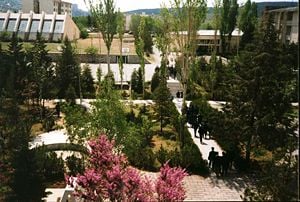
Education is compulsory and free from ages six to 15. Children may attend kindergarten from age six. The elementary school provides eight years of education for children between the ages of seven and 15. In primary school, basic information, Turkish language, mathematics, sciences, social sciences, art, music, physical education, handicraft, English language, and sometimes another foreign language (generally French or German) are taught. There are two types of elementary schools, public (governmental) and private.
At the end of eighth grade, students take a 100-question exam, OKS, which lasts for two hours. It tests skills in Turkish, mathematics, natural and social sciences learned through the elementary school. According to their scores, they are placed to different kinds of high schools.
The high school lasts for four years, with some high schools having an additional one year of English preparatory classes. The different kinds of high schools of the Turkish education system include: Public high schools, Anatolian high schools which boost language skills by instructing part of science courses in a foreign language (English, German or French), science high schools focusing on science education; vocational high schools, which focus on a vocation like tourism, industry, and electrical work, Imam-Hatip high schools, which educate imams, and private high schools established by private enterprises. Almost all private high schools give education in English (some lessons are in English) and teach a second foreign language.
When students complete the tenth grade, they choose tracks leading to certain specializations. There four tracks are: Turkish-math, science, social sciences and languages. In vocational high schools no tracks are offered, while in science high schools only the science track is offered. Tracks lead to presumed professions.
- Turkish-math track professions are: International relations, law, education, psychology, economy, business management, among others.
- Science track: Engineering, computer science, medicine, and other science related professions.
- Social science track: History, geography, and education.
- Language track: All language-linguistics professions.
At the end of twelfth grade, students take a high school finishing examination and they are required to pass this in order to take the ÖSS and continue their studies at a university.
Universities provide either two or four years of education for undergraduate studies whereas for graduate studies, a further two years is necessary. There are around 820 higher education institutions including universities with a total student enrollment of over one million.
The literacy rate is 95.3 percent for men and 79.6 percent for women, for an overall average of 87.4 percent. The low figure for women is attributed to prevailing feudal attitudes against women in the Arab- and Kurdish-inhabited south-eastern provinces.
Class
Wealth and education determine social status. Turkey has the wealthy urban educated class, the urban middle class, the urban lower class, the large rural landowner class, and the general rural population. A university education is the minimum qualification for entry into the urban educated class, in which there are numerous substrata. Most members of the urban upper class speak at least one Western language, are familiar with European or American life and culture, and are connected to the diplomatic and foreign business communities. The urban lower class includes semiskilled and unskilled laborers, low-paid service workers, and the urban unemployed. The high rate of migration of young villagers to urban areas makes this the most rapidly growing class. About 30 percent of the population is rural farmers, often referred to as peasants.
Culture
Turkey has a diverse culture that is a blend of various elements of the Oğuz Turkic and Anatolian, culture of the Ottoman Empire (which was itself a continuation of both Greco-Roman and Islamic cultures), and Western culture and traditions which started with the Westernization of the Ottoman Empire. This mix is a result of the encounter of Turks with the peoples who were in their path during their migration from Central Asia to the West. As Turkey transformed from the religion-based former Ottoman Empire into a modern nation-state with a strong separation of state and religion, an outpouring of artistic expression followed. In the early years of the republic, the government invested in museums, theaters, and architecture. Turkish culture, therefore, is a product of efforts to be "modern" and Western, combined with traditional religious and historical values.
Architecture
Ottoman architecture, with its Byzantine and Islamic elements, mastered the technique of building vast inner spaces confined by seemingly weightless yet massive domes, and achieving perfect harmony. Leaders of the new republic, who wanted to catch up with the material culture and technology of the West, turned to contemporary western European styles. Ankara was transformed from an insignificant town of 20,000 people, to a modern capital with monumental government buildings symbolizing the ambitions of the new state. The Western buildings had indoor plumbing and electricity. Turkey's first skyscraper, a commercial office building, was built in 1959 in Ankara. Since the 1950s, growing squatter settlements surrounded modern city centers, to the extent that by 2007, between 50 and 60 percent of Turkey's urban population lived in such housing. Most Turkish homes are divided into a (a public reception room) and a "harem" (private family quarters). Traditionally, male guests stay in the public reception room, while women stay in the harem. Traditional homes have an enclosed courtyard where women can perform domestic tasks.
Cuisine
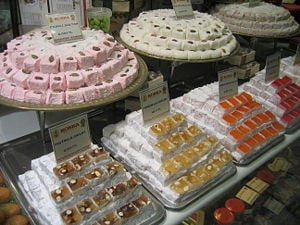
Turkish cuisine blends ingredients and recipes inherited from the territories covered by the Ottoman Empire with the Turkic and Central Asian cuisine. Turkish cuisine is not homogeneous. Aside from common Turkish specialties which can be found throughout the country, there are also region-specific specialties. The Black Sea region's cuisine is based on corn and anchovies. The southeast is famous for its kebabs, mezes and dough-based desserts such as baklava, kadayıf and künefe. Especially in the western parts of Turkey, where olive trees are grown abundantly, olive oil is used for cooking. The cuisines of the Aegean, Marmara and Mediterranean regions display basic characteristics of Mediterranean cuisine as they are rich in vegetables, herbs and fish. Central Anatolia is famous for its pastry specialties such as keşkek, mantı, and gözleme.
Cities have numerous restaurants and snack stands. Some specialize in kebabs, soups, meat wraps made with pide (a flat bread), pastries, and fish. Others offer stews, pilafs, vegetables, and deserts. Some restaurants cater for workers, who eat only breakfast and the evening meal at home. Higher-class restaurants set aside a section for women and families. American fast-food chains have become popular. Pork is forbidden to Muslims.
Many Turks drink beer, wine, and liquors. There are a few local brands of lager such as Tekel Birasi and Marmara34 and a large variety of international beers. There are a variety of local wines such as Kavaklıdere, Doluca, Kayra, Pamukkale and Diren. Rakı, a traditional alcoholic beverage flavored with anise, is the usual drink with meze, fish or kebabs. Tea is commonly drunk throughout the entire day, thick coffee usually taken after a meal, ayran (buttermilk), and boza (a fermented bulgur drink taken in the winter). Carbonated soft drinks have become popular with young people.
Etiquette
Older men should be addressed with the title "bey" (mister), and women with the title "hanim" (lady). Adults of the opposite sex may not act casually or show affection toward each other in public. Friends of the same sex may hold hands and greet each other with kisses on the cheek. Men shake hands upon meeting, but a man does not shake a woman's hand unless she extends it to him. Business meetings are preceded by tea and unrelated conversation. Consideration for companions is important. One does not drink, smoke, or eat something without first offering to share it with one's companions.
Literature
The history of Turkish literature is traced back to the Orkhon inscriptions. Most Turkish literature was verbal before the arrival of Islam, which brought Persian structures, such as mesnevi and gazel. In the nineteenth century, artists began to use western structures.
Poetry dominates modern Turkish literature. The poetic tradition may be traced back to the thirteenth century, when folk poetry began to emerge. There are two poetic traditions: the aşık/ozan style, which was mostly secular; and the explicitly religious style, which emerged from the gathering places of the Sufi religious orders and Shi'a groups.
Much aşık/ozan poetry, being almost exclusively oral until the nineteenth century, remains anonymous, and few poems have survived, the eleventh century Turkic epic Köroğlu being one of them. Aşıks were minstrels who traveled through Anatolia performing their songs on the bağlama, a mandolin-like instrument. The aşık/ozan tradition was revived in the twentieth century by Aşık Veysel Şatıroğlu (1894–1973), Aşık Mahzuni Şerif (1938–2002), Neşet Ertaş (1943– ), among others.
Ottoman divan (collected works) poetry was a highly ritualized and symbolic art form, having inherited from Persian poetry a wealth of symbols whose meanings and interrelationships were prescribed. In the early years of the Republic of Turkey, authors including Ahmed Hakim and Ya Kendal Beatle (1884–1958) continued the Ottoman tradition of formal verse.
Less formal “Grip” poets Orhan Veli Kanık (1914–1950), Melih Cevdet Anday (1915–2002), and Oktay Rifat (1914–1988) sought to create a popular art, and were inspired by contemporary French poets like Jacques Prévert. A further group of poets, including Turgut Uyar (1927–1985), Edip Cansever (1928–1986), Cemal Süreya (1931–1990), Ece Ayhan (1931–2002), and İlhan Berk (1918– ), reacted against the Garip movement and sought to create a more abstract poetry through the use of jarring and unexpected language, complex images, and the association of ideas.
Other significant poets include Fazıl Hüsnü Dağlarca (1914– ), who wrote poems dealing with life, death, God, time, and the cosmos; Behçet Necatigil (1916–1979), whose somewhat allegorical poems explore middle-class daily life; Can Yücel (1926–1999), a poet and translator; and leftist poet İsmet Özel (1944– ), whose poetry since the 1970s has shown a strong mystical and even Islamist influence.
The backgrounds of twentieth century novelists can be traced back to "Young Pens" (Genç Kalemler) journal in Ottoman period, which had a nationalistic perspective of social and political issues. With the declaration of the republic, Turkish literature became interested in folkloric styles, and mixed western and traditional forms.
Orhan Pamuk, a leading Turkish novelist of post-modern literature, was hugely popular in Turkey, and his work had been translated into more than 20 languages. Pamuk won the Nobel Prize for Literature in 2006, with his melancholic point of view of various cultures in Istanbul.
Movies
The first film showing in Turkey was held in the Yıldız Palace, Istanbul, in 1896. The first Turkish movie, a documentary produced by Fuat Uzkinay in 1914, depicted the destruction of the Russian monument in Ayastefanos. Before 1950, Turkish cinema was greatly influenced by the theater as well as by World War II. After 1950, Turkish cinema was able to develop as a separate art, with a more professional caliber of talents. Between 1950 and 1966, Turkey had more than 50 movie directors. The film "Susuz Yaz" (Dry Summer), made by Metin Erksan, won the Golden Bear Award at the Berlin Film Festival in 1964.
In 1970, approximately 220 films were made and this figure reached 300 in 1972. Turkish cinema gave birth to its legendary stars, including Kemal Sunal, Kadir İnanır, Türkan Şoray and Şener Şen. After this period however, the cinema began to lose its audiences, due to nationwide TV broadcasts. After 1970, a new and young generation of directors emerged, but they had to cope with an increased demand for video films after 1980.
Music
The music of Turkey includes elements of Central Asian folk music, Arabic, Persian classical music, ancient Greco-Roman music and modern European and American popular music. The biggest Turkish pop star of the twentieth century was probably Sezen Aksu, known for her light pop music, and for overseeing the Turkish contribution to the Eurovision Song Contest
European classical composers in the eighteenth century were fascinated by Turkish music, particularly the key role given to the brass and percussion instruments in Ottoman Janissary bands, the first marching military bands. Joseph Haydn wrote his Military Symphony to include Turkish instruments, as did Ludwig van Beethoven in his Symphony Number 9, and Mozart wrote the "Ronda alla turca" in his Sonata in A major. Although this Turkish influence was a fad, it introduced the cymbals, bass drum, and bells into the symphony orchestra, where they remain.
Sport
The most popular sport in Turkey by far is football (soccer), with certain professional and national matches drawing tens of millions of viewers on television. Nevertheless, other sports such as basketball and motor sports (following the inclusion of Istanbul Park on the Formula 1 racing calendar) have also become popular. The traditional Turkish national sport has been the Yağlı güreş (oiled wrestling) since Ottoman times.
Notes
- ↑ Turkish Statistical Institute. Turkstat.gov.tr. Retrieved May 16, 2011.
- ↑ 2000 census. Citypopulation.de.Retrieved October 21, 2011.
- ↑ The World Bank: World Development Indicators Database. Gross Domestic Product 2010, PPP. Last revised on 1 July 2011. Retrieved October 21, 2011.
- ↑ The World Bank: GDP, PPP (current international $) Retrieved October 21, 2011.
- ↑ The World Bank: GDP per capita, PPP (current international $) Retrieved October 21, 2011.
- ↑ The World Bank: World Development Indicators Database. Gross Domestic Product 2010. Last revised on 1 July 2011. Retrieved October 21, 2011.
- ↑ The World Bank: GDP (current US$) Retrieved October 21, 2011.
- ↑ The World Bank: GDP per capita (current US$) Retrieved October 21, 2011.
- ↑ Gini Index. World Bank. Retrieved March 2, 2011.
- ↑ The Turkish lira (Türk Lirası, TL) replaced the Turkish new lira on January 1, 2009.
ReferencesISBN links support NWE through referral fees
- Bal, İdris. 2004. Turkish foreign policy in post cold war era. Boca Raton, FL: BrownWalker Press. ISBN 1581124236
- Çarkoğlu, Ali, and Barry M. Rubin. 2006. Religion and politics in Turkey. London: Routledge. ISBN 0415348315
- Extra, Guus, and D. Gorter. 2001. The other languages of Europe: demographic, sociolinguistic, and educational perspectives. Clevedon, UK: Multilingual Matters. ISBN 1853595098
- Finly, Carter Vaughn. 2004. The Turks in World History. Oxford University Press, USA. ISBN 0195177266
- Goodwin, Godfrey. 1971. A history of Ottoman architecture. Baltimore: Johns Hopkins Press. ISBN 080181202X
- Hale, William M. 1994. Turkish politics and the military. London: Routledge. ISBN 0415024552
- Huston, James A. 1988. Outposts and allies: U.S. Army logistics in the Cold War, 1945-1953. Selinsgrove: Susquehanna University Press. ISBN 0941664848
- Kinross, Patrick Balfour. 1977. The Ottoman centuries: the rise and fall of the Turkish empire. New York: Morrow. ISBN 0688030939
- Manco, Ural. "TURKS IN EUROPE: FROM A GARBLED IMAGE TO THE COMPLEXITY OF MIGRANT SOCIAL REALITY."
- Mango, Andrew. 2000. Atatürk. Woodstock, NY: Overlook Press. ISBN 1585670111
- Mango, Andrew. 2004. The Turks Today. Overlook. ISBN 1585676152
- Mango, Cyril A. 2002. The Oxford history of Byzantium. Oxford: Oxford University Press. ISBN 0198140983
- Nas, Tevfik F., and Mehmet Odekon. 1992. Economics and politics of Turkish liberalization. Bethlehem: Lehigh University Press. ISBN 0585231249
- Pope, Hugh and Nicole, 2004. Turkey Unveiled. Overlook. ISBN 1585675814
- Rubin, Heper, Metin. 2002. Political Parties in Turkey. Routledge (UK). ISBN 0714652741
- Shankland, David. 2003. The Alevis in Turkey the emergence of a secular Islamic tradition. London: RoutledgeCurzon. ISBN 020341750X
- Shaw, Stanford J., and Ezel Kural Shaw. 1976. History of the Ottoman Empire and modern Turkey. Cambridge: Cambridge University Press. ISBN 0521212804
- Wink, André. 1991. Al-Hind, The making of the Indo-Islamic world. Leiden: E.J. Brill. ISBN 9004095098
External links
All links retrieved May 2, 2023.
Credits
New World Encyclopedia writers and editors rewrote and completed the Wikipedia article in accordance with New World Encyclopedia standards. This article abides by terms of the Creative Commons CC-by-sa 3.0 License (CC-by-sa), which may be used and disseminated with proper attribution. Credit is due under the terms of this license that can reference both the New World Encyclopedia contributors and the selfless volunteer contributors of the Wikimedia Foundation. To cite this article click here for a list of acceptable citing formats.The history of earlier contributions by wikipedians is accessible to researchers here:
- Turkey history
- Geography_of_Turkey history
- Name_of_Turkey history
- Demography_of_Turkey history
- Turkish_people history
- Religion_in_Turkey history
- Education_in_Turkey history
- Turkish_cuisine history
- Cinema_of_Turkey history
- Ankara history
The history of this article since it was imported to New World Encyclopedia:
Note: Some restrictions may apply to use of individual images which are separately licensed.

